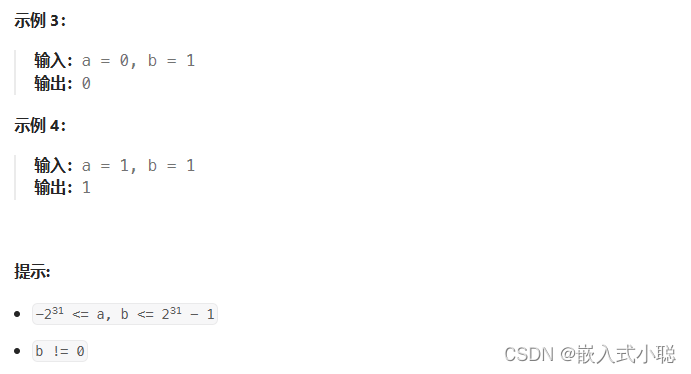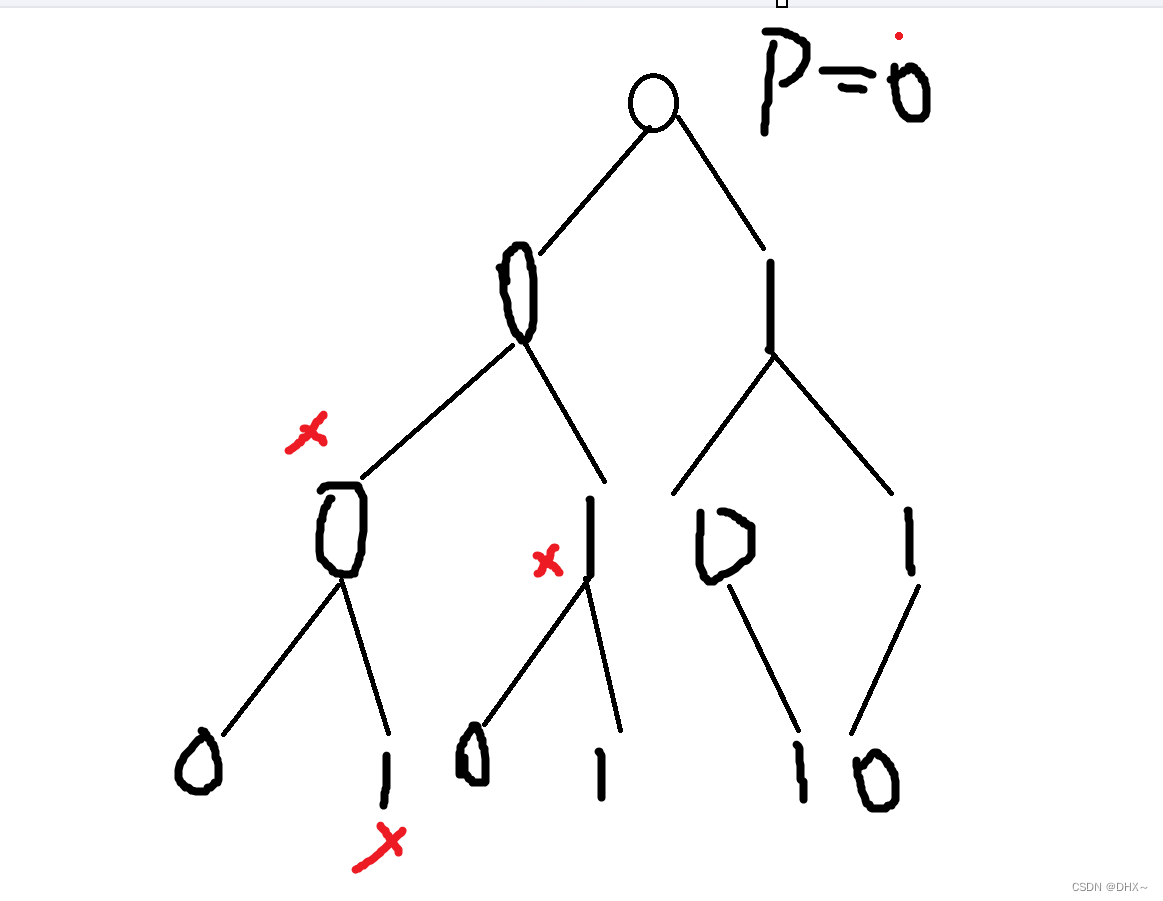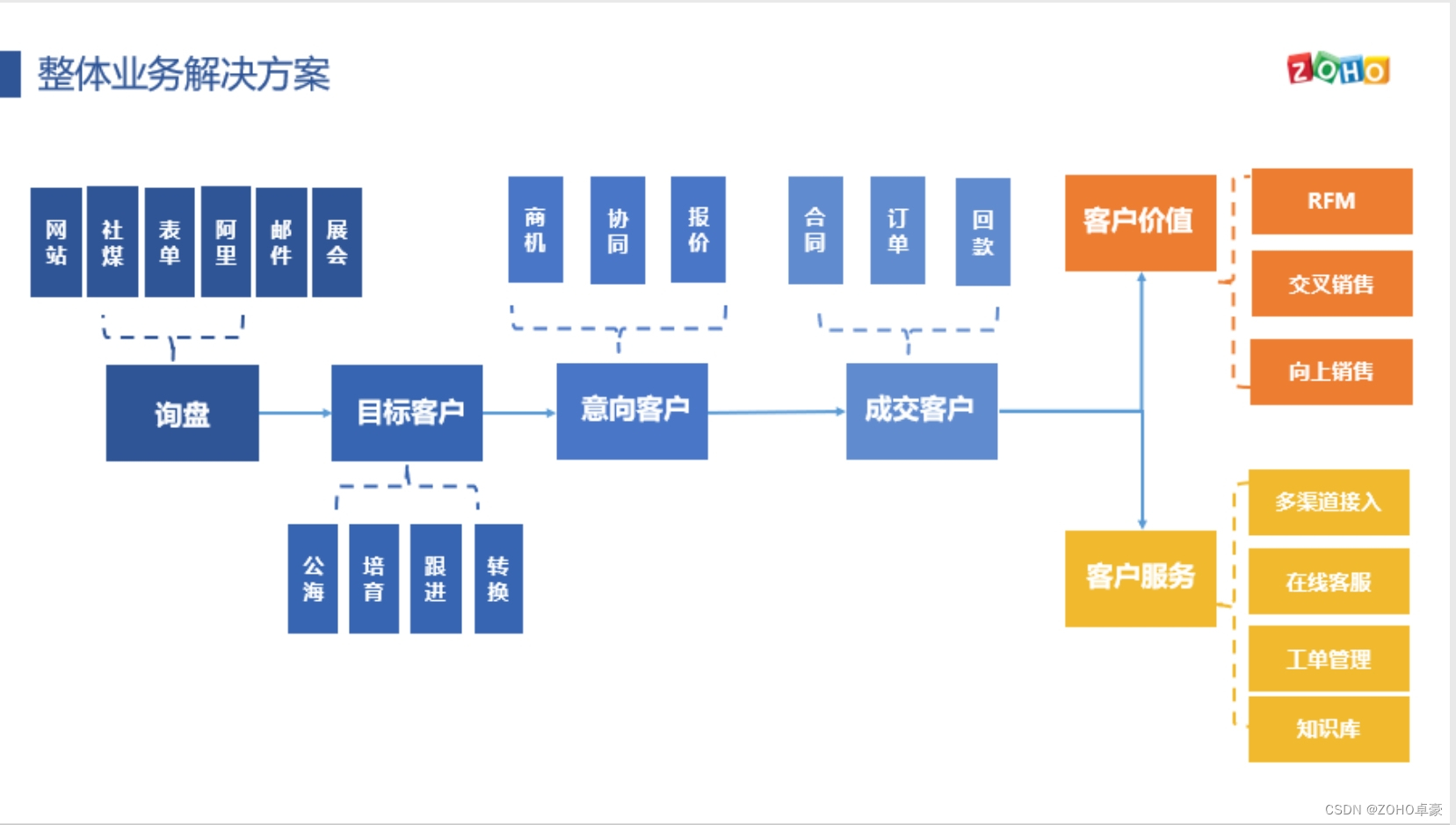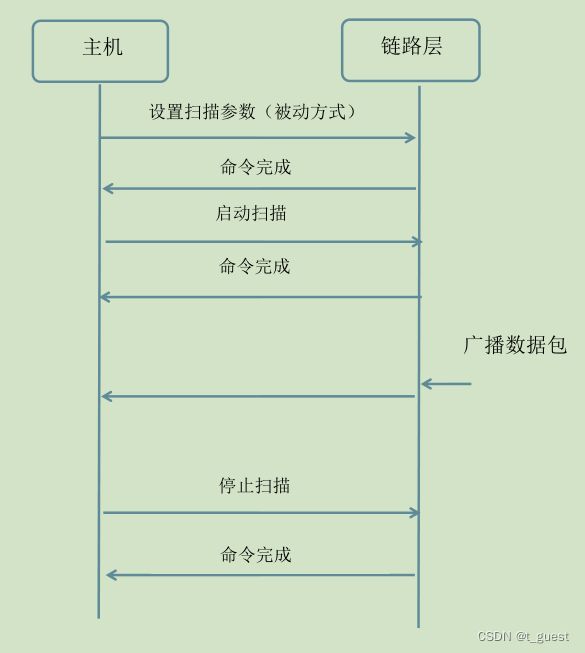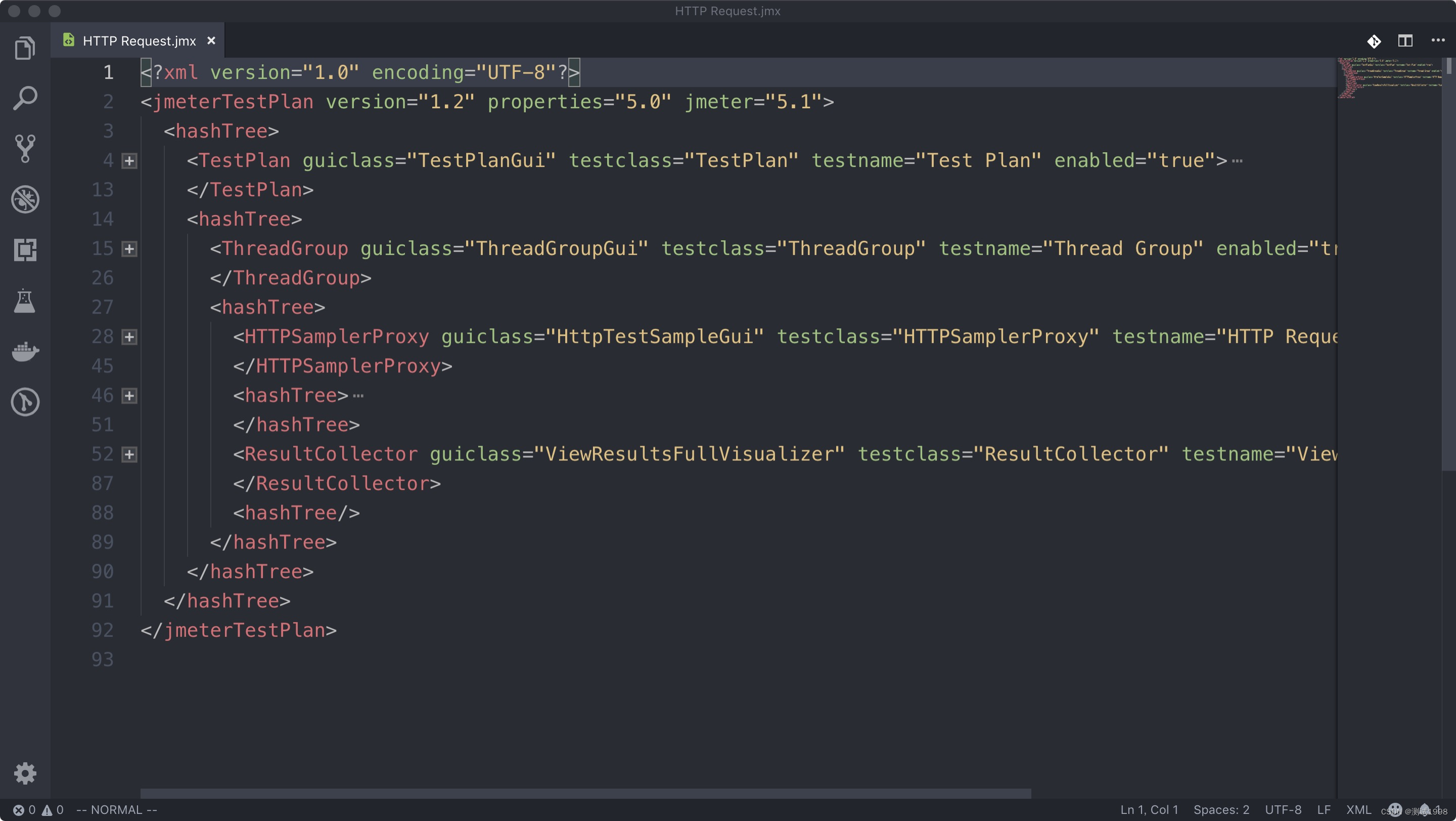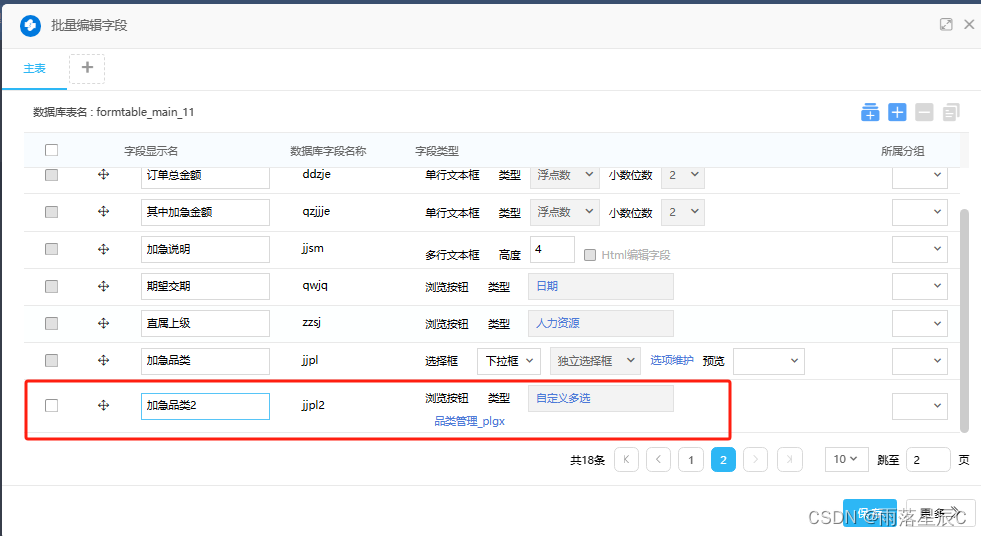TOEFL Preparation Specialization
Specialization Certificate
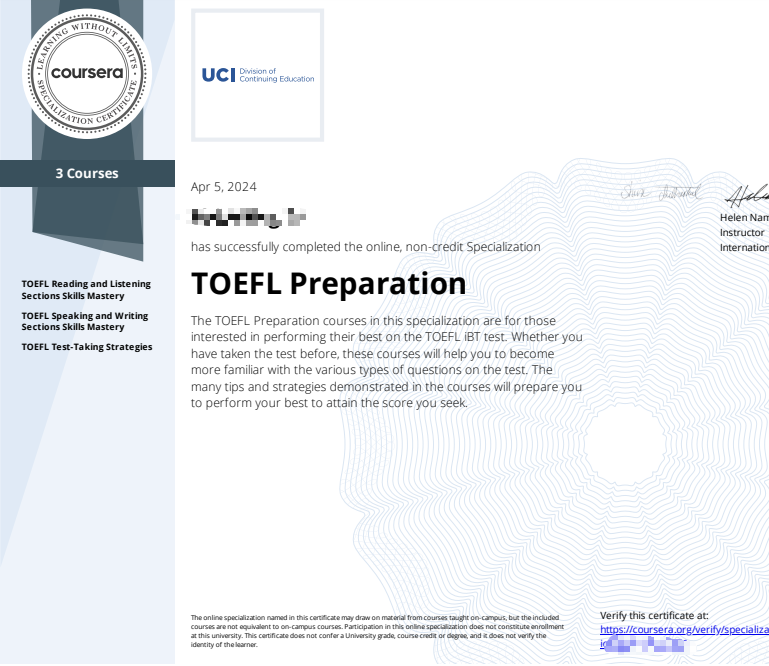
TOEFL Test-Taking Strategies
Course Certificate
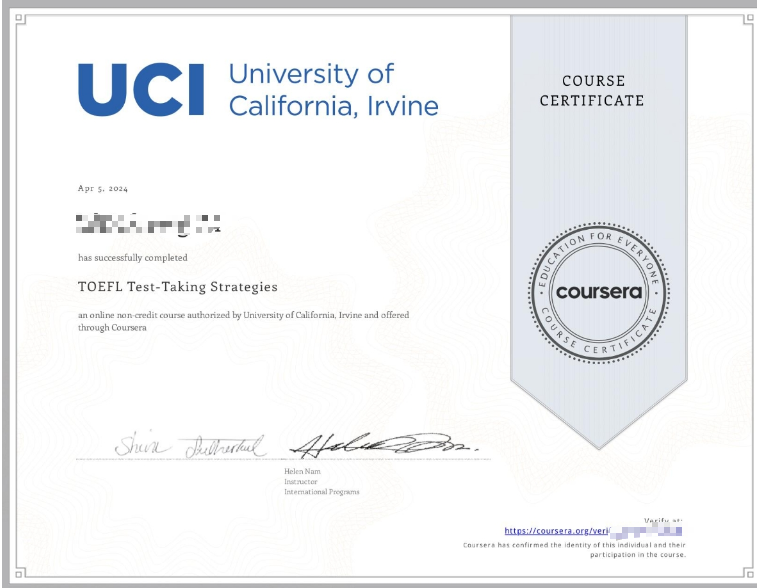
本文是学习 TOEFL Test-Taking Strategies 这门课的学习笔记,如有侵权,请联系删除。
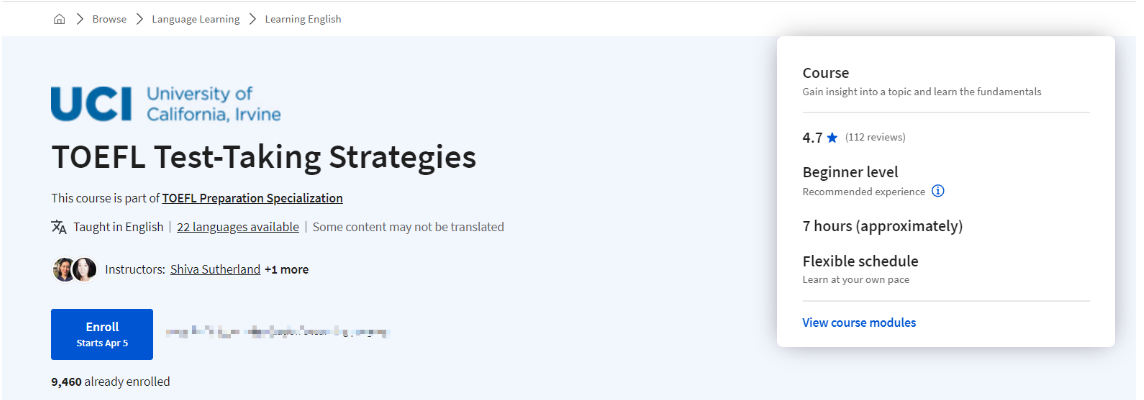
文章目录
- TOEFL Preparation Specialization
- TOEFL Test-Taking Strategies
- Week 01: TOEFL iBT Reading Strategies & Tips
- Learning Objectives
- iBT TOEFL Reading Tips
- iBT Reading Strategies (Part 1)
- iBT Reading Strategies (Part 2)
- Quiz: Reading Tips & Strategies
- Week 02: iBT Listening Strategies & Tips
- Learning Objectives
- iBT Listening Tips
- iBT Listening Strategies (Part 1)
- iBT Listening Strategies (Part 2)
- Quiz: Listening Tips & Strategies
- Week 03: iBT Speaking Tips & Strategies
- Learning Objectives
- iBT Speaking Tips & Strategies
- iBT Speaking Strategies (Part 1)
- iBT Speaking Strategies (Part 2)
- Quiz: Speaking Strategies & Tips
- Week 04: iBT Writing Tips & Strategies
- Learning Objectives
- iBT Writing Tips
- iBT Writing Strategies (Part 1)
- iBT Writing Strategies (Part 2)
- Quiz: Writing Tips & Strategies
- 后记
vowel: 元音 美 [ˈvaʊəl]
consonant:辅音
Week 01: TOEFL iBT Reading Strategies & Tips
In this first week, you will become familiar with some effective reading strategies that can help you answer the questions that you will encounter on a real iBT reading section. You will be able to apply the right strategies for the right question types and be more prepared for the test by improving your vocabulary and reading comprehension skills.
Learning Objectives
- Learners will become familiar with some effective reading strategies.
- Learners will practice some strategies that will prepare them for iBT reading questions.
iBT TOEFL Reading Tips
Top TOEFL Reading Tips
It’s time to start your preparations for the Reading Section of the iBT exam. After all, careful preparation is an essential part of a successful TOEFL reading strategy. Here, we are going to look at some general tips that can help you do better in the iBT Reading Section.
Tip #1: Read…a lot
This might sound a little obvious, but one of the best ways to prepare for the Reading test is to read!
As you prepare for the exam, the most effective TOEFL Reading tip is to devote time daily to actively read similar types of texts to those you might see on the test day (mostly academic).
As you read, take note of the vocabulary and expressions that are unfamiliar to you, and make sure that you have a clear understanding of the main points. By reading a little every day, you will soon begin to see improvements in how quickly and effectively you can process texts in English.
Another great way to practice for the test is paraphrasing and summarizing the passages you read. Every time you finish reading a text, set aside some time to summarize the passage and check your understanding of the main points. You don’t want to write too many details in your summary but want to retain the gist of the passage. This activity will help you retain the main points and their connection to each other and the whole passage.
Moreover, when you read a passage and try to paraphrase it by using your own words, you won’t be fooled by the test items that use keywords from the passage but are not related to the question.
Tip #2: Manage Your Time
One of the key skills required to pass the Reading section is good time management. For this one, one TOEFL Reading tip is to dedicate about five minutes to each passage in the section, with one minute for each question.
You can work on your time management by reading more frequently to increase the amount of information you can process in one sitting. Additionally, there’s no better training than practice tests themselves. Schedule a few mock Reading tests into your preparation schedule and track how your pace increases**.** It is a good idea to keep track of your reading speed across all your practices and aim for your speed to increase.
Tip #3: Skim and Scan the Passage
Skimming and scanning are two effective reading strategies that you can use not only in iBT but in almost every context that involves reading. Skimming is reading rapidly to obtain a general overview of the material. You are looking for main points which are often in key sentences such as a paragraph’s first/topic sentence. You come away from skimming by being able to say what the passage is about. Think of buying a book at a bookstore: you look at the title, the author, a description of what the book is about, and some general information to help you decide if you want to buy it or not. Scanning is reading rapidly to locate specific information quickly. It is done by moving your eyes quickly down the page and searching for the particular bit that you are looking for which may be a name, a date or other number, or specific words and phrases. Be clear what you are seeking. Are you looking for a number? A several-word phrase? A proper noun that will be capitalized? Even though you are not reading every word as you scan, since you have clarified the kind of information you are looking for, you are more likely to find that material rapidly. Learning to expand your peripheral vision can help with this approach.
Tip #4: Vocabulary Counts
A great way of improving your reading comprehension skills is by building your vocabulary. As you read in preparation for the test, note down the words you don’t know and make your personal vocabulary list.
TOEFL Reading passages tend to use similar language from one test to another. This means that by practicing with sample tests, you will build your TOEFL vocabulary and reduce the possibility that you will encounter unfamiliar language on test day. As a way of remembering new terms, group the vocabulary you encounter according to their meaning or category of use and make a note of relevant synonyms and antonyms.
For tips and strategies on vocabulary learning, you can go back to Course 1, Module 4 and review the vocabulary learning tips we studied. For a great list of academic vocabulary, follow the link below. It includes more than 300 useful words that can help you understand academic tests more effectively. Ultimate TOEFL Vocabulary List: The 327 Best Words to Know • PrepScholar TOEFL
Tip #5: Use Your Understanding of Essay Organization
We explored the Writing Section of iBT in Course 2, Modules 3 and 4. We learned that your essays need to start with the thesis statement and include topic sentences along with supporting sentences and details. This is true for the organization of most standard texts, as well. You can use this knowledge to understand reading passages as an organized and meaningful message and not as a series of sentences with no pattern. When you read, remember to use the following strategies:
- Read the entire passage from its start to its finish.
- Identify the passage’s main ideas.
- What are the supporting details?
- What is the relationship between these two items?
- Identify common organizational patterns you know from articles.
- Connecting words are often a clue to organizational patterns. Pay attention to these.
- Write a text summary after reading, making sure that it incorporates the same pattern of organization as the reading.
- Note that certain connecting words and transitions reflect specific relationships between ideas.
- Steps in or order of a process — first, second, next, finally
- Reasons — since, because
- Consequences— as a result, so, therefore
- Examples — for example, such as
- Relationships— in contrast, on the other hand
- Restating information — in other words, that is
- Conclusions — in conclusion, in summary
- When a text presents two opinions, be sure to mention both opinions in your summary and reflect the correct relationship between them.
- Analyze the relationship between the opinions.
- Focus on how the end of one sentence is related to the beginning of the next.
- State the ideas in a single sentence choosing transition words that best capture the relationship between ideas.
To summarize, in order to be prepared for the Reading section of iBT, you need to devote time to read and improve your speed of reading and vocabulary. As you read, make sure you practice techniques that help you understand the passage effectively and efficiently. Practice skimming, scanning, summarizing, and paraphrasing each time you read. Now, make sure you watch the lecture videos to learn more about reading strategies.
iBT Reading Strategies (Part 1)
Welcome to Course 3, Module 1. In the first part of this presentation we’re
going to look at some iBT reading strategies that can help you answer some of these
questions on the test. Let’s take a look at the
question types first. In Course 1, Module 2, you became familiar with
different question types, let’s review them before
we look at the strategies. As you can remember, there are nine different kinds of questions in each
iBT reading section. They are; Factual and Negative factual
information questions, Vocabulary questions,
Rhetorical purpose questions, Inference questions, Sentence
simplification questions, Insert text questions, and finally Fill in a
table questions.
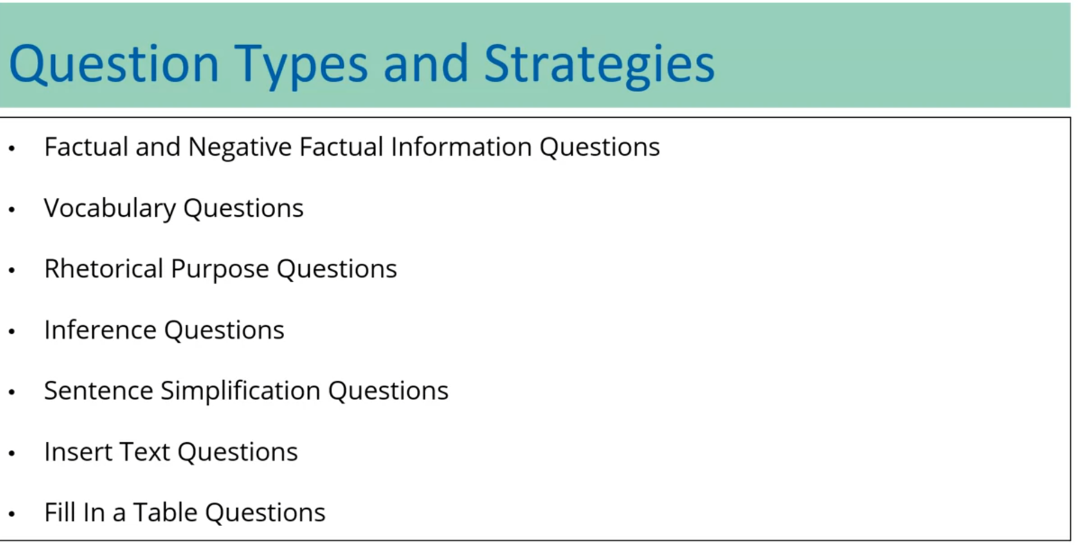
As mentioned in
Course 1, Module 2, factual questions and negative
factual questions ask about explicit facts and details that are
given in the passage. They often contain
questions about what, who, when, where, why, and so on. The best strategy to answer these questions is
to scan the passage. That means reading quickly
to find certain information. To answer factual questions and negative factual questions, you must scan the passage
or paragraph to locate and identify information that
the question asks about. Then you need to compare the
information that you read, with the answer choices.
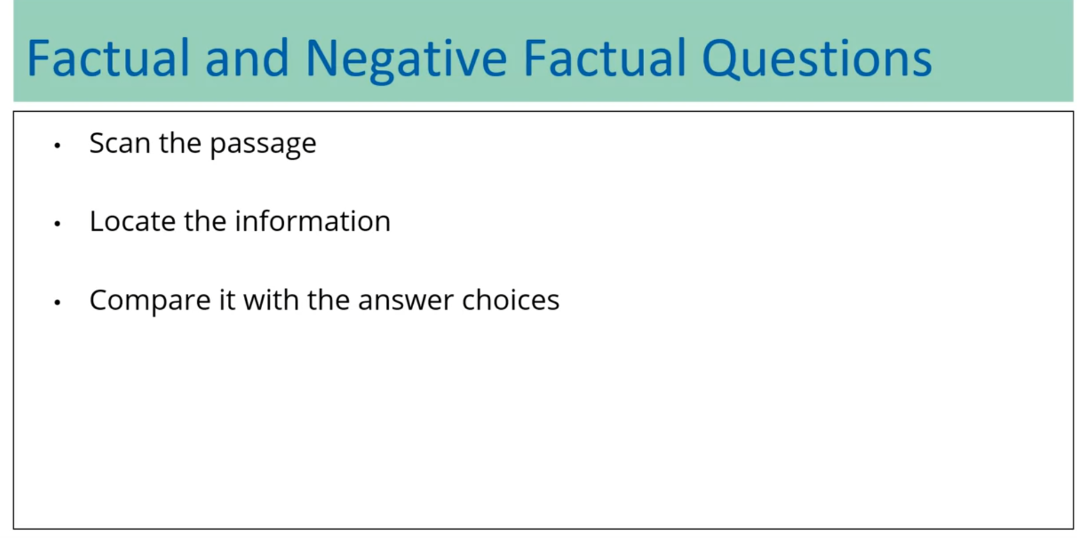
Now let’s practice this strategy with this sample question. You’ll have 45 seconds to read this paragraph and answer the question that
follows. Let’s read. Now here is a question about the same paragraph
that you just read. According to the paragraph, which of the following is
true about the US and Japan? You will have 30 seconds
to make your choice. If you chose answer
D, That is correct, because when we look for the keywords from the
question in the passage, the sentence that
contains the US and Japan explains how the were considered
first-world countries. Since they are not
mentioned again, there is no need to look further.
Now let’s look at
vocabulary questions. Here are some
strategies that you can follow when you answer
vocabulary questions. Number one, look at the
highlighted word or phrase and the four
answer choices. If you’re familiar with the word, guess which answer is correct and check it
against the context. Number two, read the sentence
in which the word appears. Remember the words will be highlighted so it’s
very easy to find. Then see if the context clues in the sentence or in
the sentences before, or after, help you guess
the correct meaning. Number three, if context
clues do not help you guess the meaning of the
word, use word analysis. In other words, [inaudible]
the prefix root, or suffix can help you
understand the word. Number four, if you still are not sure which answer is correct, read the sentence
to yourself with each of the four answer
choices in place. Does one seem more logical given the context
of the sentence, than the other three? If not, do any seem illogical? If so, you can eliminate
those. Number five. If you’re still not sure, make the best guess that
you can, then go on. If you have time, come back to this question later.

Let’s look at a sample question. You might already know what
interconnectedness means. If you don’t, probably the best strategy here
will be word analysis. Can you dissect
different parts of interconnectedness and
find out what it means. Here are your four choices. The word interconnectedness
is closest in meaning to a, association b, interrogation c, dependence
d, togetherness. The answer is a,
because association is closest in meaning
to interconnectedness. We learn that by
analyzing the word into its different parts;
inter-connect(ed)-ness.
Inference questions. The answers to these
questions are not directly provided in the passage, which means you have to read between the lines to answer them. In other words, you need
to read and understand that information beyond the words and sentences that you see. Also, make sure your answers do not contradict the main
idea of the passage. Do not choose an answer just because it seems
important or true. The correct answer must be
inferable from the passage. You should be able to defend
your choice by pointing to explicitly stated information in the passage that leads to the inference you have selected.
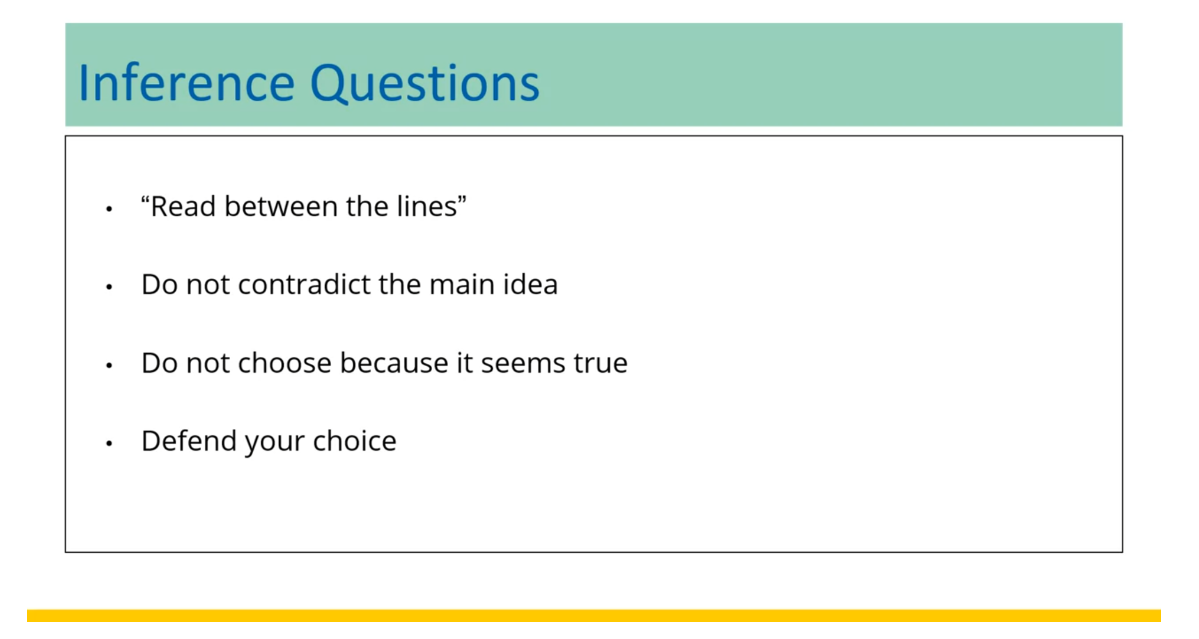
Now let’s practice that strategy
with a sample question. You’re going to have
45 seconds to read this paragraph and answer the question that
follows. Let’s begin.
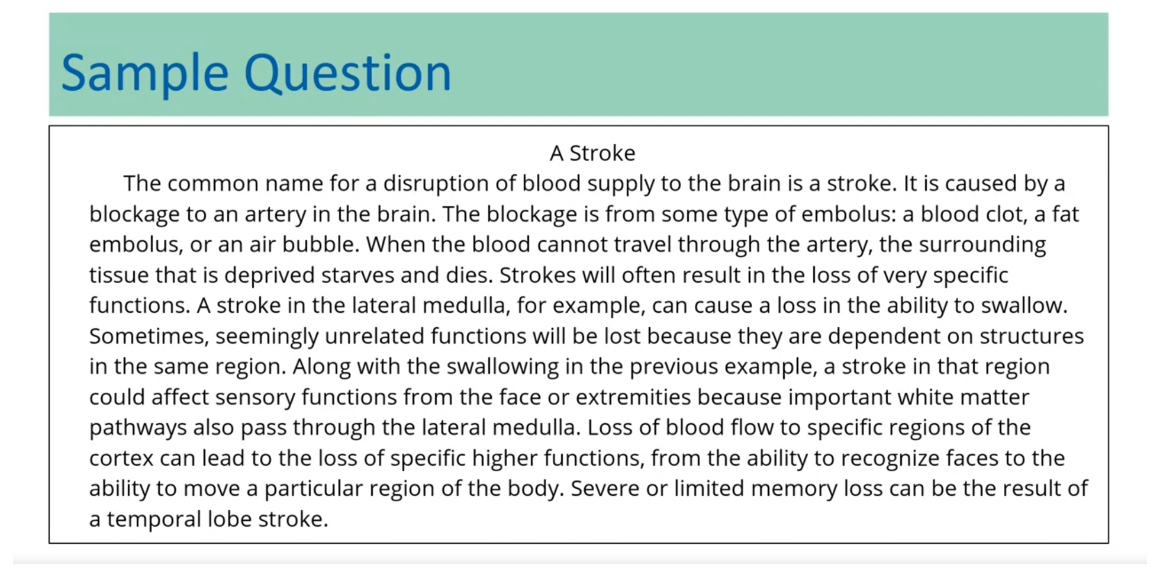

Now here is a question based on this same paragraph
you just read. You’ll have 30 seconds
to make your choice. The answer is c, because the passage
explains how strokes in certain regions of affect or cause a loss of
certain functions. B is incorrect because the passage states that it
will result in the loss of very specific functions
and later states along with the swallowing
in the previous example, the stroke in that
region could affect providing more than
one bodily function that gets damaged. This is the end of the first
part of this presentation. We will continue looking at
other types of questions and strategies in the second
part. See you soon.
iBT Reading Strategies (Part 2)
Welcome back to iBT reading strategies,
part two. We’re going to continue looking at
different question types and strategies. Rhetorical purpose questions. These questions asked why or
how, in other words, they ask you why an author makes a point? Or why or how the author supports and
strengthens the point in a certain way? Either way, they’re about how
the passage is developed. In order to answer these questions
correctly, you need to use reasons and logic, and imagine that you are the author
and have written the passage. Why would you use this example,
or word, or statistics?
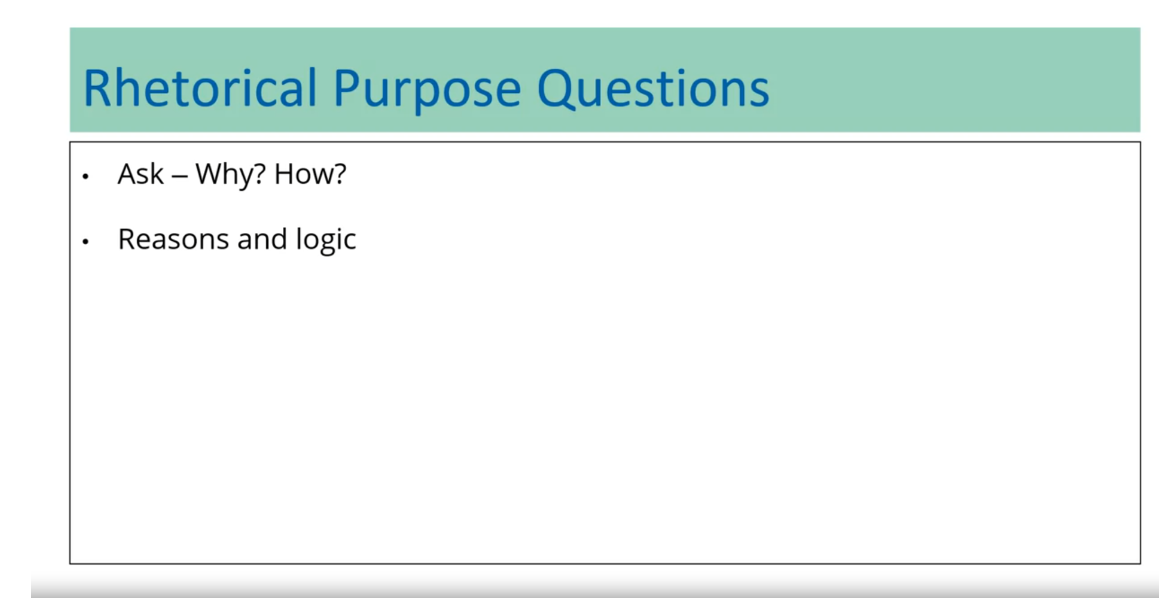

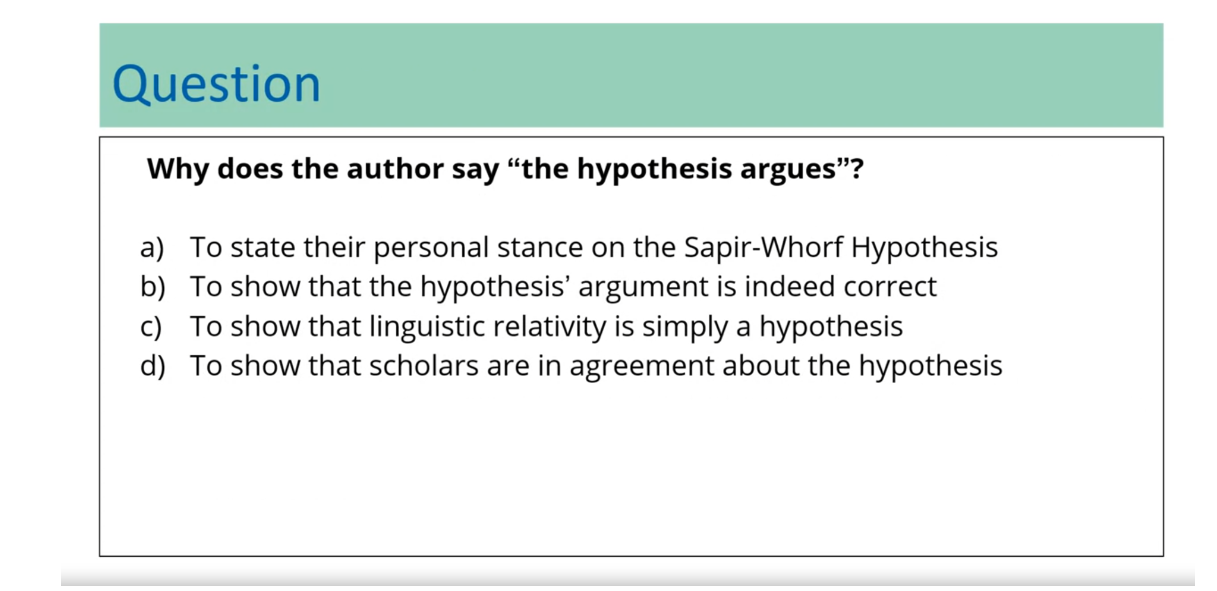
It’s time to practice again. Look at the sample questions,
you have 45 seconds to read it and answer the question that follows,
you may begin now. Now this is the question about
the same paragraph you just read. Why does the authors say
the hypothesis argues? The correct answer is c. Because the author uses this short phrase,
the hypothesis argues, to emphasize that this hypothesis,
also called linguistic relativity, is just a claim and
not necessarily proven or agreed upon.
Sentence restatement or
sentence simplification. The best strategy is to
use are paraphrasing, summarizing, and
understanding essential information. From the reading part of this module, you remember the difference between
paraphrasing and summarizing. Now it’s time to use this
strategy to answer this question.


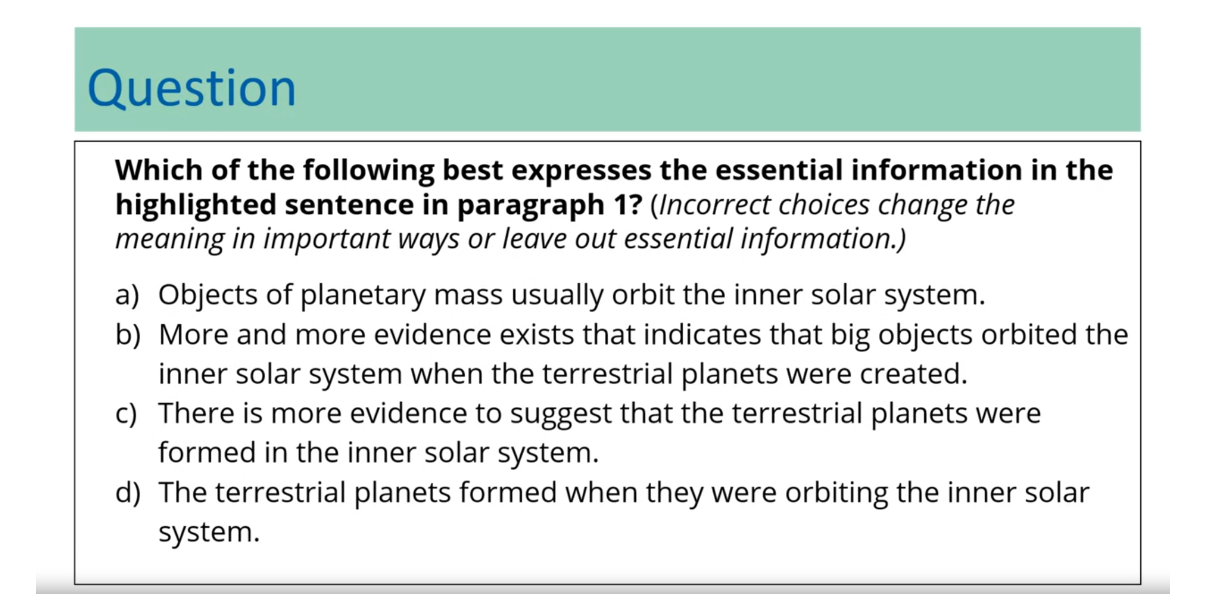
Let’s look at an example. You have 45 seconds to
read this paragraph and answer a question that follows,
let’s begin. Here’s the question based on
the same paragraph you just read. Which of the following best
expresses the essential information in the highlighted
sentence in paragraph one? Incorrect traces changed
the meaning in important ways or leave out essential information. Here, the correct answer is b. Because the main point is that there
is increasing evidence that proves that large chunks of material we’re in orbit at
the time the terrestrial planets formed.
Insert text questions. These questions test your
understanding of correct sequencing of paragraph organization and
especially of paragraph cohesion. You can think of cohesion as
the glue that holds the sentences of a paragraph together. When you answer these questions,
pay special attention to signal words. These are words that help you
with information about where the sentence should be placed. These can be demonstratives like this or
these. They can be transition words like however,
moreover, etc. Or they can be synonyms or
words that share the same meaning.
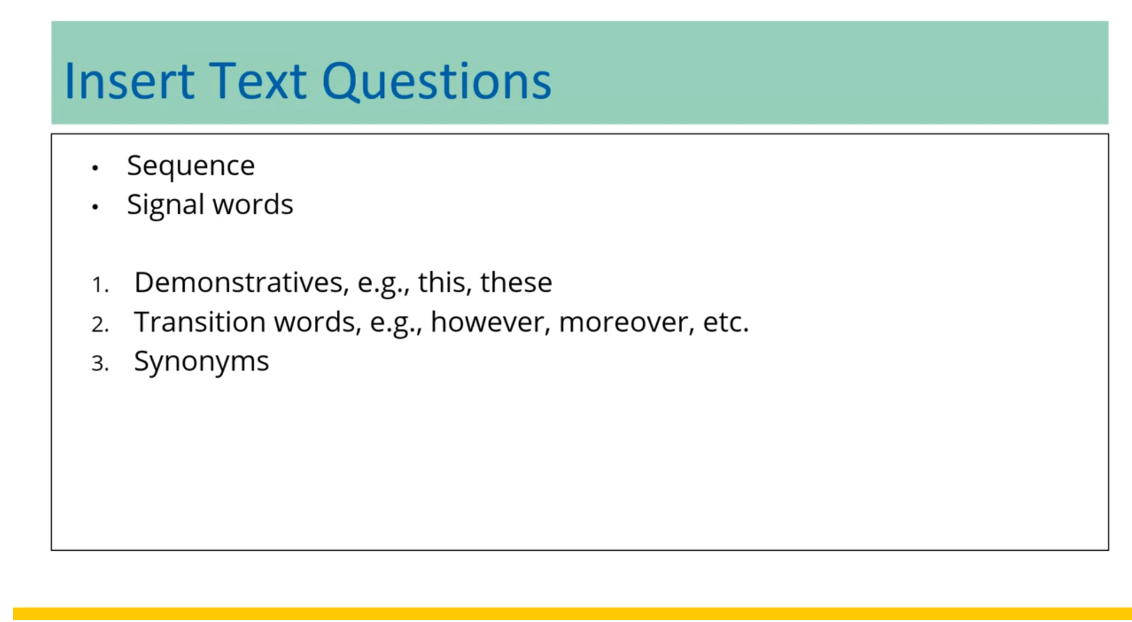
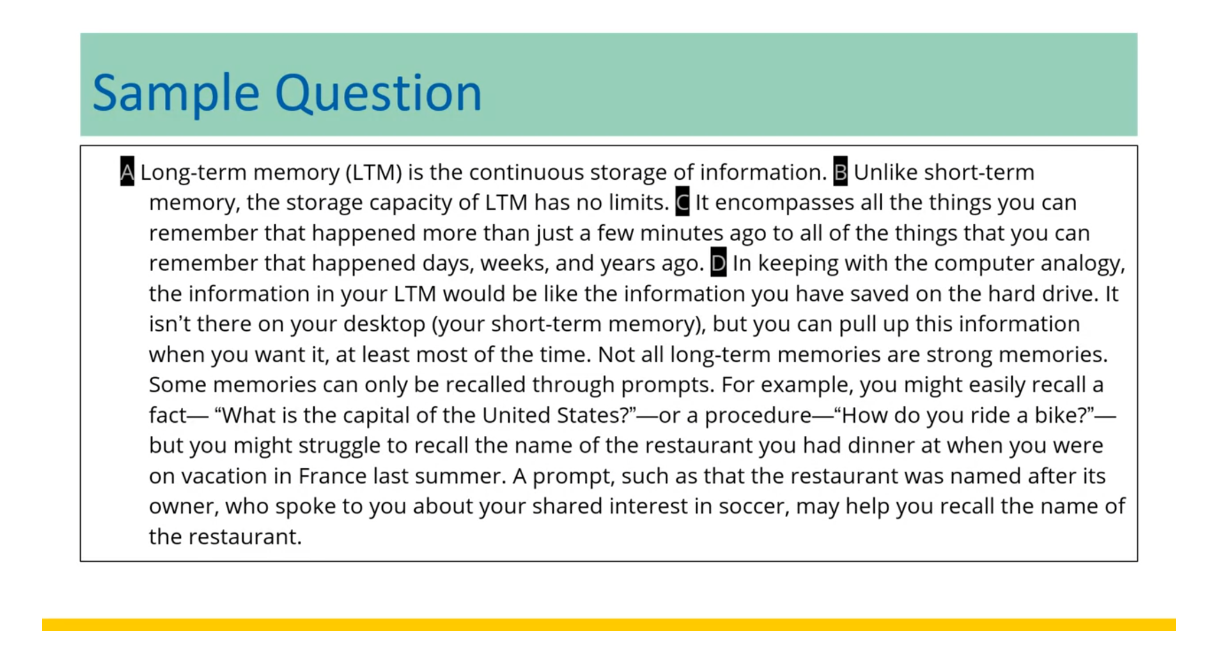

It’s time to practice again,
read this paragraph and answer the question that follows. You have 45 seconds to read. Here’s the question. In paragraph one,
there is a missing sentence. Look at the four squares [A, B, C, D] that indicate where
the sentence could be added. Where would the sentence below best fit? It is defined in contrast
to short-term memory. You may need to pause this video and go
back and check the paragraph once again. The correct answer is B. It is correct because the missing sentence
contains the pronoun referent, it, which refers back to long term-memory, which
is mentioned in the previous sentence. The sentence that comes after
the missing sentence compares or rather contrasts long-term and
short-term memory. The missing sentence introduces or sets
the context for the following sentence. It does not make sense at
the beginning of the paragraph because the paragraph cannot start with it.
Fill in a table/chart questions. Here are some strategies that can
help you answer these questions. Start looking at the two or three categories of information
given in the chart or table. Be sure to understand the concepts and
the differences between them. If you do not,
then go back to the passage. Two, locate the answer choices
one by one in the passage. Remember the choices might be
scattered all over the passage, not just in one paragraph. Also, remember that the information
in the answer choices will not appear the same word for
word as the information in the passage. Three, using your note paper,
take simple notes about each choice. Just write down the letter for
the choice and then the abbreviation for the categories. If you’re not able to
categorize the choice, write a question mark,
and go back to it later. Four, now use your notes,
click on the choices that you are sure of, and
put them in the right category. If all the blank spaces in
the chart are not full, go back and look at the choices you
marked with a question mark. Reread the paragraph and
see if you can classify those choices. If not, guess.
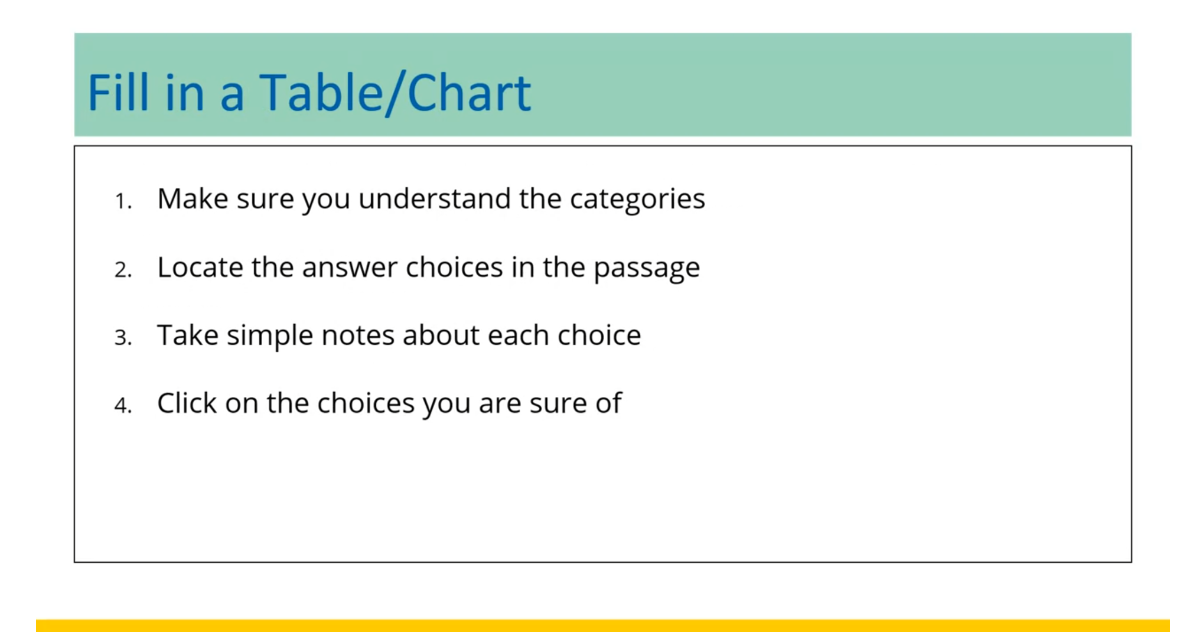
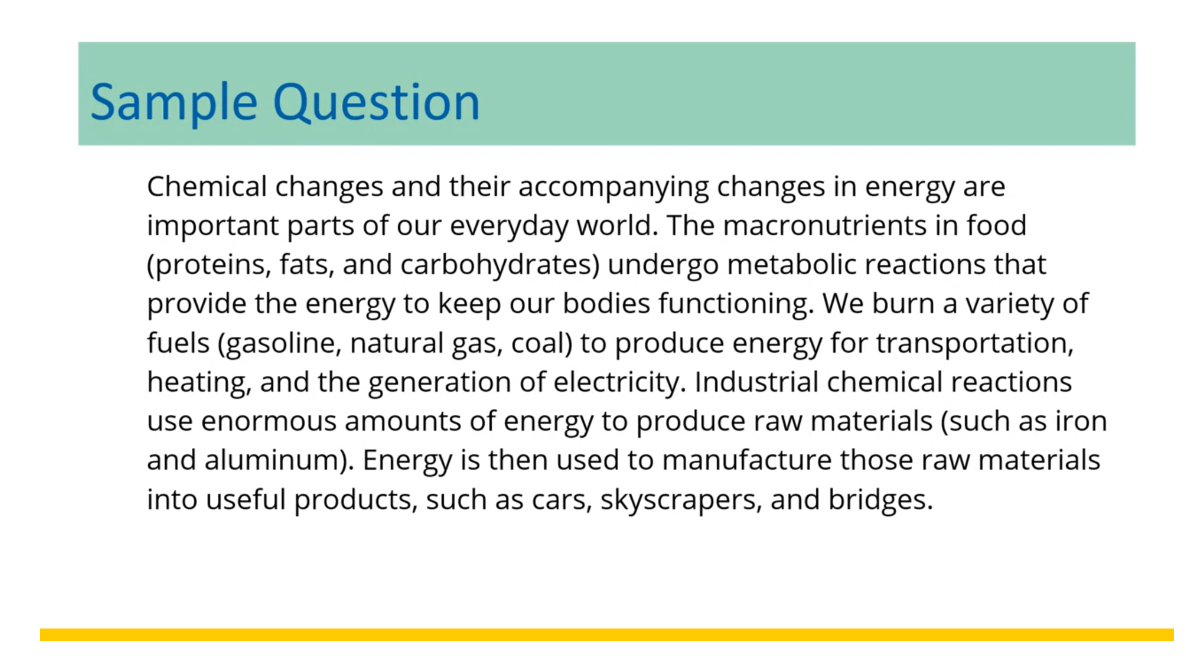
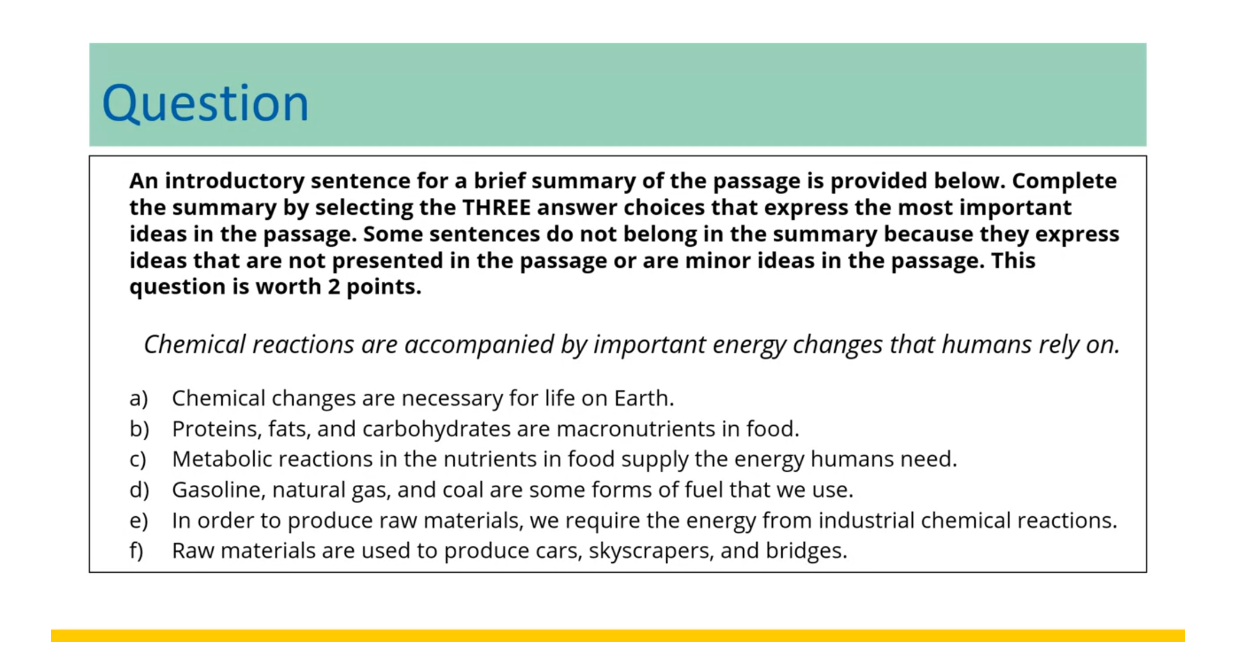
Time to practice again. Here is the sample paragraph. You’ll have 45 seconds to read it and
answer the question that follows. And here’s the question based
on the paragraph you just read. These types of questions
usually take longer, so feel free to pause this video and
read the choices carefully. Correct answers are A, C, and E. Because these options are related to
the main topic in the summary sentence and do not just provide extra details but
summarize or introduce broader topics. Options, B, and C, and F are details that
are not related to the summary sentence. This is the end of this presentation. In the next module, we’ll look at
different question types in the reading section and the strategies that
can help you answer the questions.
Quiz: Reading Tips & Strategies
Choice:
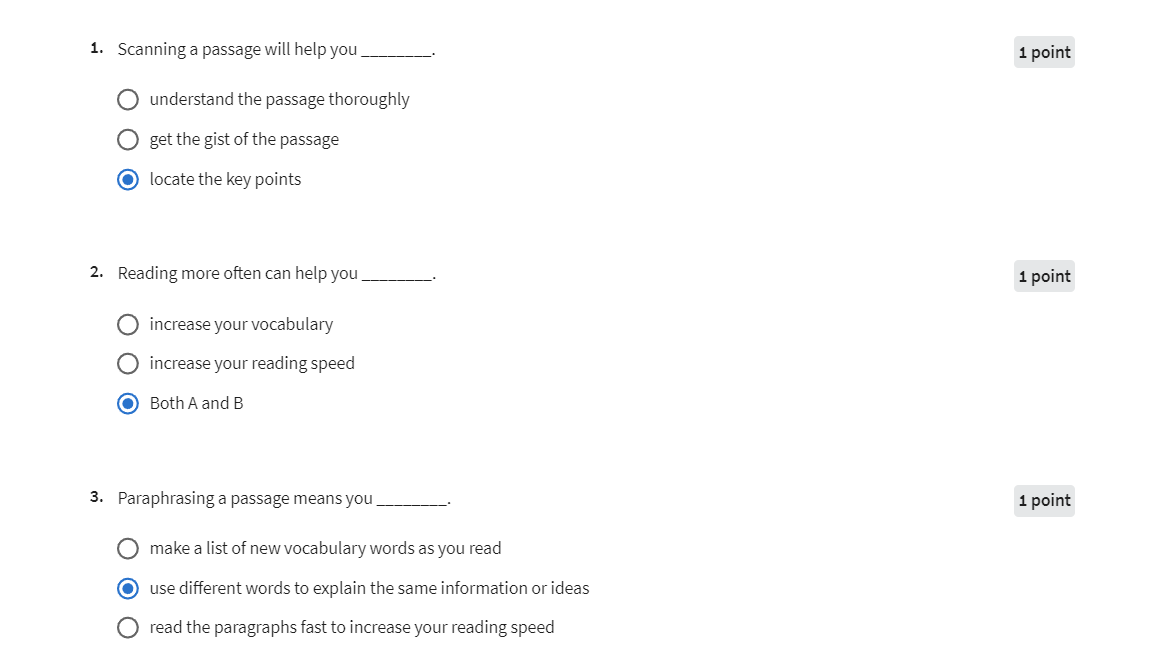
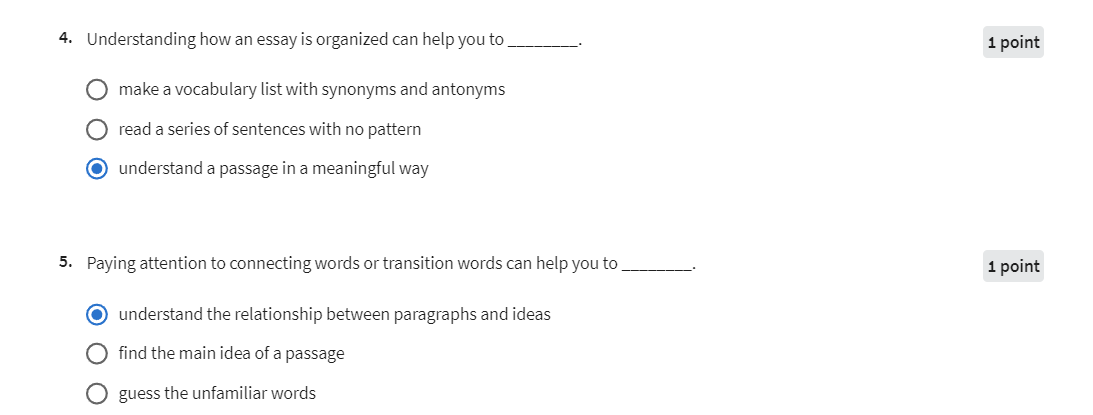
Answer
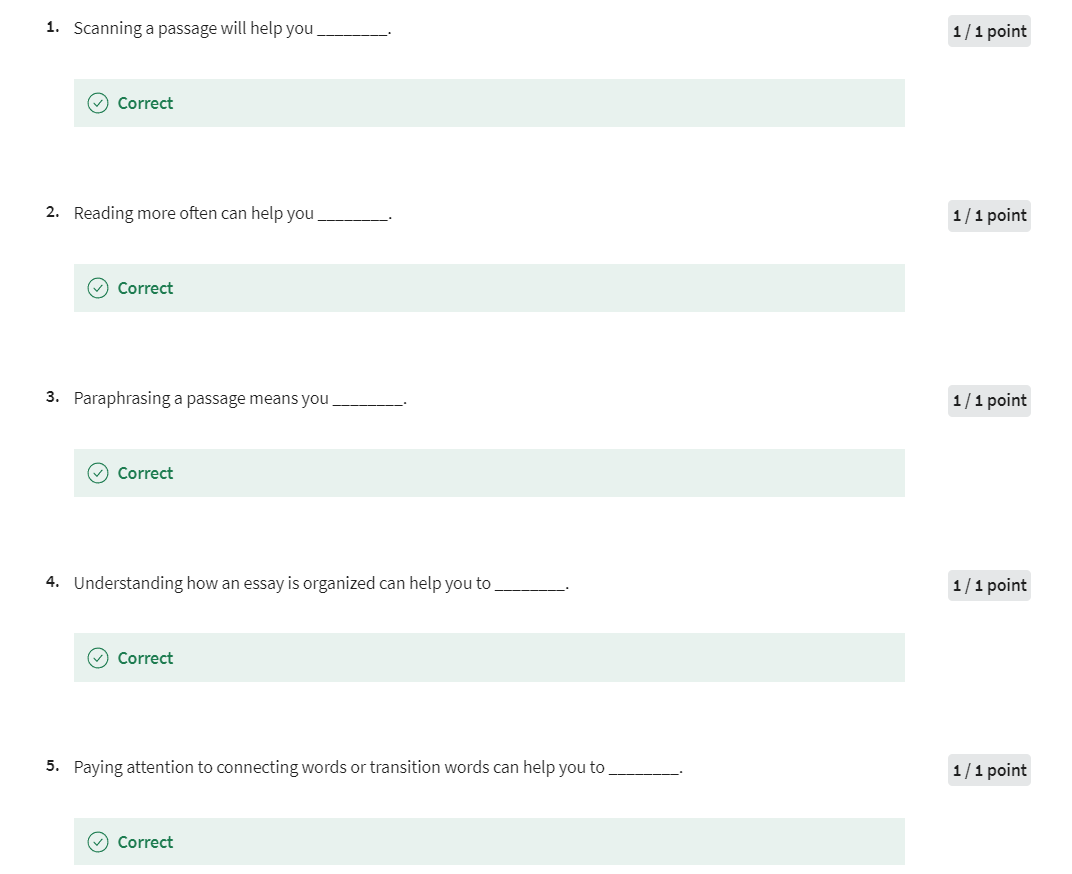
Week 02: iBT Listening Strategies & Tips
In this second week, you will become familiar with some effective listening strategies that can help you answer the questions that you will encounter on a real iBT reading section. You will be able to apply the right strategies for the right question types and be more prepared for the test by improving your listening comprehension and note-taking techniques.
Learning Objectives
- Learners will become familiar with some effective listening strategies.
- Learners will practice some strategies that will prepare them for iBT listening questions.
iBT Listening Tips
The Listening Section of the iBT exam measures many different factors such as overall comprehension, purpose, implied meaning, and so on. However, there are other factors that can affect your listening comprehension in general. This week, we are going to look at some of these important factors.
1. English Sounds
When you listen to any audio in English, you should be able to correctly hear and recognize the sounds. This may sound too obvious, but sometimes this is challenging in practice. For example, lamp and lamb sound very similar except for the last sound. These sounds may even confuse native speakers. You should work to ensure that you can hear slightly different but definite sounds in English, such as between “d”, and “t”, or “b” and “p” or “l” and “r”, etc.
One way to practice distinguishing sounds in English is through listening and transcribing what you hear. You can listen to a song or the news, pause the audio frequently and simply write down everything you hear. After a while, you will notice that understanding the words and sounds will become easier for you.
2. English Stress and Intonation(英语重音和语调)
You may have heard that “language is music” because of each language’s unique sound system. English is one of the most musical languages due to its stress and intonation patterns. Intonation is the use of correct tone of voice and pitch(音高) when you speak a language. In some iBT questions, what you hear can have a different meaning depending on the intonation pattern. Therefore, it is key to your listening comprehension to know the tones of 1) important words and 2) sentence transitions. Moreover, if you are used to one form of an English accent such as American or British English, start listening to other accents as well. Afterall, the Listening section includes a variety of native-speaker English accents including from the U.S. and Canada, the U.K., Australia, and New Zealand. This variety will better represent the various accents you might hear while in an English-speaking environment.
3. Paraphrasing and Inferencing
Just like reading, when you listen, you need to be able to understand the concept not by putting words together but by understanding the entire message beyond surface words and structure. While listening to TOEFL audio material as you practice, consider other words the speaker could have used. This practice will benefit you on test day since the correct answer choice often paraphrases the text instead of presenting a direct quotation. Also, the speaker may use a word you do not know. In these cases, be ready to use your guessing skills if you can. Practice paraphrasing in listening in the same way you practice it in reading. This will help you not to focus only on the words and structure you hear, but also pay attention to the meaning that is there.
Build your inference-making skills, as well. This practice involves identifying information you know to form a guess about information that you are not directly given; in other words, “reading between the lines.” You already know how to make an inference while reading by looking for clues in a text and matching these with your own experiences and knowledge. This helps you determine what is not directly written. This is inferring information. The same strategy applies to making an inference while listening. A classic example is that if a speaker mentions that the time is approaching noon, that she did not eat breakfast, and that her stomach is rumbling, you may correctly infer that she is hungry.
4. Understand How to Approach Conversations (了解如何进行对话)
The listening that is tested in the TOEFL involves two different speech types: lectures and conversations. The lectures are like what you would hear in a large university course. They are planned, organized and quite formal. Like academic writing in English, they are also most commonly straightforward.
However, like conversations in everyday English, the conversations in the TOEFL test are frequently not so direct. If you become familiar with several aspects of conversational English that can make them a challenge to follow, your listening comprehension and TOEFL score will increase. Let’s look at common conversational-English features that you should recognize and accommodate(适应).
Verbal pauses (语言停顿): Speakers in English conversation use verbal pauses in their speech when they are considering what to say next. You might hear um, er, ah or other sounds that aren’t actual dictionary words. In addition, you might hear actual words such as well, I suppose, let me see, so, now, etc… These do not correspond to the conversation topic, but give speakers a moment to hold their position in a conversation or to have time to organize what they will say next. Identify the topic of the conversation, follow it as it moves ahead, and be patient with these verbal pauses. They are giving the speaker (and you!) a moment.
Repetition: While we learn not to repeat material when we write in English, conversational language frequently features repetition. People in a conversation are most commonly “speaking in the moment.” They do not have the benefit of editing as they would with something they write. While editing in writing usually removes repeated words or ideas, conversation is a negotiation of meaning that occurs in real time. Ideas are often said more than once.
Interruptions: Conversation styles differ among international cultures and even within one nation’s style of spoken expression. Conversation elements also change depending on whether it is a formal or informal exchange or based on a speaker’s emotions or age, for instance. You may hear a speaker interrupted in a conversation in English or even hear the speaker “self-interrupt” to add information or change the direction of a conversation. The thing to remember is that conversations are frequently fluid, with stops and starts and “bumps” in how messages progress. Once again, consider whether an interruption might be changing the topic or whether it is simply the speaker getting off track before returning to the original thought.
“Talking over:” One kind of challenging interruption to decipher is when both people in a conversation speak at the same time with different information. This is “talking over.” The original speaker might hope to hear an “excuse me” when this happens because “talking over” isn’t generally a polite pattern, but this works out differently depending on when and where it happens. A t.v. debate? An emotional discussion? A conversation with an impatient friend? Any listener may lose important information when you observe “talking over.” Still, keep your attention on the general topic and retain the information you can. The conversation, especially in a TOEFL listening sample, will quickly return to just one person speaking.
Misspeaking: Sometimes speakers unintentionally or unknowingly use a wrong word or phrase. This “misspeaking” can confuse a listener. Official iBT lectures may include misspoken words. However, they are more common in iBT conversation sections since these are more fast-paced and less organized than lectures.
While iBT conversations have fewer of these challenging features than what you hear in actual face-to-face conversations, it is valuable to recognize these features and be flexible and skilled in accommodating them. Your practice will help you with this.
5. Time Management Tips
Budgeting your time is critical while responding to the Listening sections of TOEFL. We know there are five recordings to manage. Also, unlike with the Reading section of TOEFL where you can re-read a passage, you cannot listen again in the Listening section. You will hear a passage once only and have only one opportunity to answer a question. You cannot go back. Answer each question as it appears even if you must guess.
How much time should you budget for each listening response? Let’s do the math. There are 16.5 combined minutes (990 seconds) of TOEFL listening. The combined number of listening questions is 28. 990 seconds/28 questions = 35 seconds per question. Because you will have taken good notes (see below), you probably will use fewer than those 35 seconds per question. In fact, some experts suggest that you take about 10-20 seconds for each question. This way, if you do need a little more time on a few questions, you’ll have it.
6. Note-Taking
Taking good notes while you listen is a central skill to develop before the test. You will need to check your notes made on test day while answering the questions. We’ll review more about this in the strategies-for-note-taking lecture.
What is your goal with note taking? Aim to keep pace with the audio and to filter what material is more and less important. In a way, taking notes is the first step in summarizing. You are concentrating but already making connections with what is being shared and what is important. In the videos, you will learn more tips to help you take notes more effectively.
7. General Tips
ETS.org has a page with some very useful listening strategies that can help you both in iBT and generally as you listen to something in English. Review the material here for excellent suggestions. Improving Your Listening Skills (For Test Takers)
Success with iBT Listening will be much more likely if you follow the tips presented above. You must also know the test format completely. The Listening section has distinct types of passages and questions. If you are familiar with these before test day, your confidence and your score will likely be higher. You will also gain “muscle memory” to be able to concentrate on the material presented, not the “how-to’s” of taking the test. If you haven’t yet taken iBT sample tests, do this several times before test day. Additionally, if you’ve skipped Course 1, Module 3, review it now.
In the lecture, we will practice some useful note-taking tips. We will also review the question types briefly as well as strategies needed to answer them.
iBT Listening Strategies (Part 1)
Welcome to Course 3, Module 2. In this presentation,
we are going to look at some iBT Listening Strategies. In the first part we’re going
to look at question types and strategies that can help
you answer the questions. Before we continue, let’s look at the question types again. One, gist content and
gist purpose questions. Two, details. Three, function questions. Four, attitude questions. Five, organization questions. Six, connecting content questions and finally, inference questions.
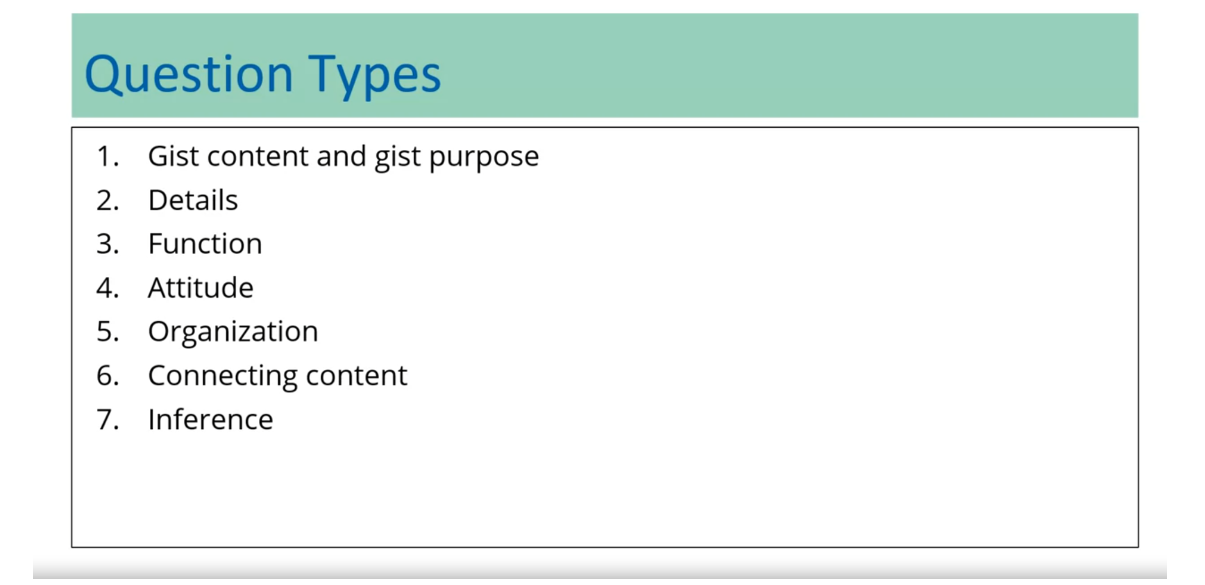
Gist content and Gist
purpose questions. These questions usually appear first in a conversation
or a lecture. They measure your
understanding of overall content of the
lecture or conversation. Be careful in conversations. The purpose of a
conversation is not always related to the main topic. Be careful to take notes. When you’re taking notes, as soon as you become aware of the main topic of the
conversation or lecture, you should write it down
and underline or circle it.
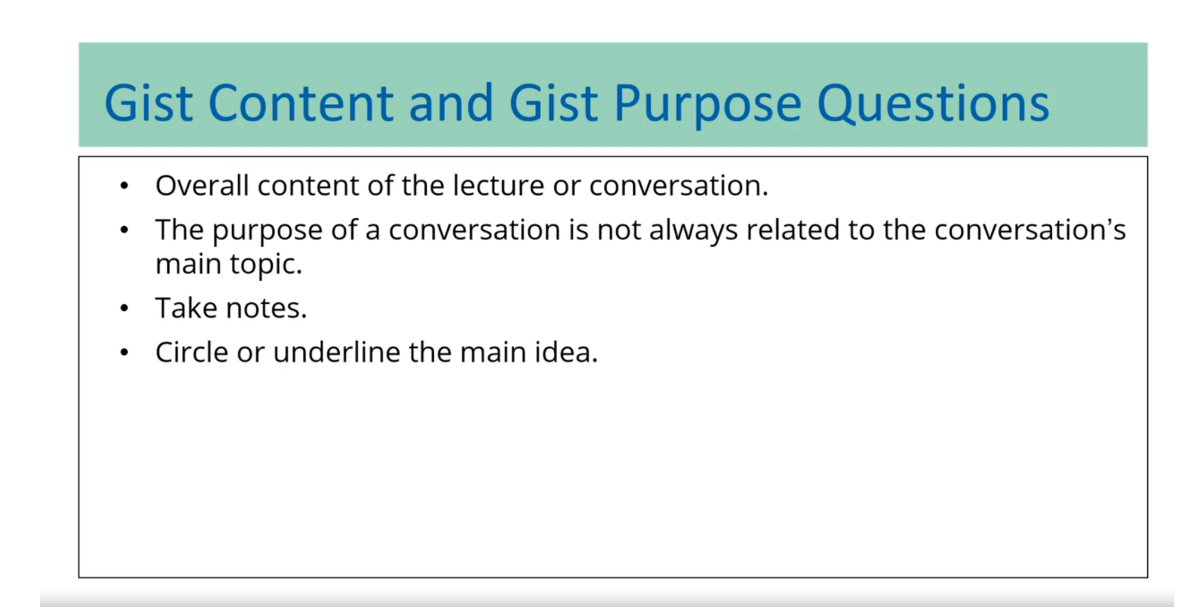
Detail questions.
For these questions, you obviously need to
take very good notes. But remember, you will
not be asked about minor points like a year
when some events happened. Your notes should
contain major details. Also, do not choose an
answer only because it has words or phrases from
the conversation or lecture. Finally, if you are unsure
of the correct response, decide which one of
the choices is most consistent with the main idea of the conversation or lecture.
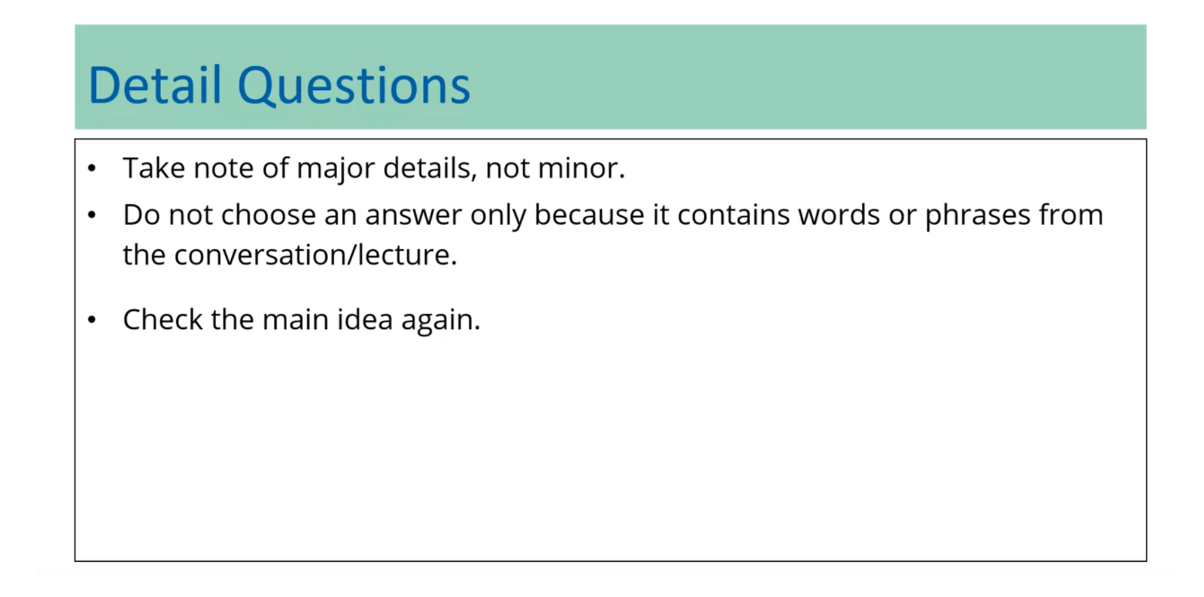
Function questions. Function questions usually
appear as replay questions. These are questions
when you see an icon of headphones that tell you when you’ll hear the replayed section. Here the focus is on
language functions. For example, is the
speaker apologizing, changing the subject,
complaining, clarifying, asking for more information,
making a suggestion, expressing doubt, interrupting
or something else. Remember, the important
point here is the function may not match what the
speaker directly states. You need to understand
beyond the surface level.
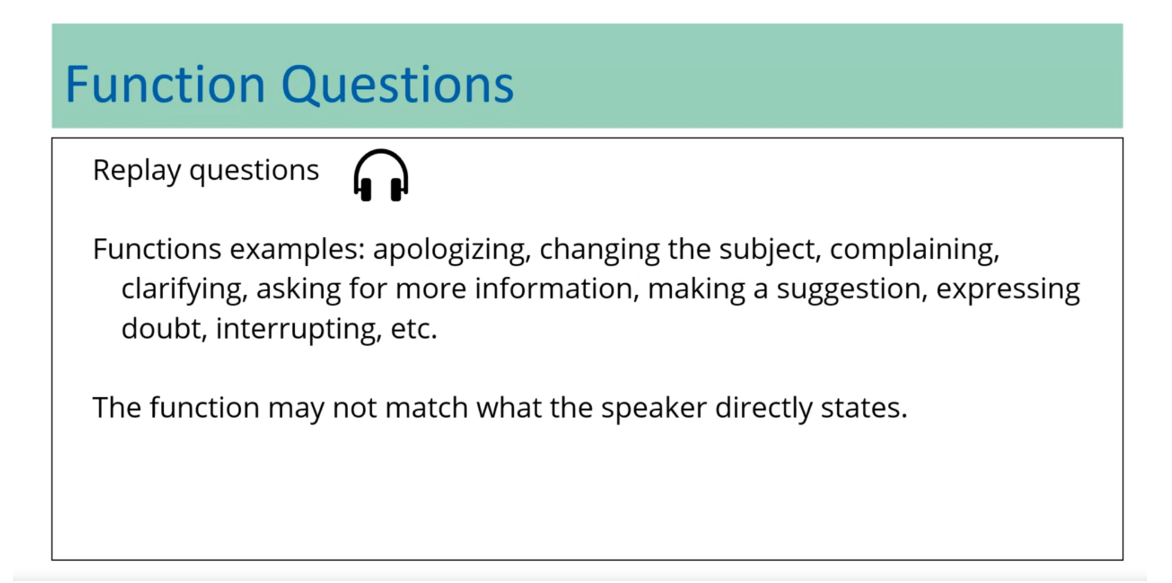
Attitude questions. The answer to these
questions is never given directly in the
conversation or lecture. Looking for these answers in
your notes may not help you. You must infer the answer
from the speaker’s tone of voice and vocabulary choice.
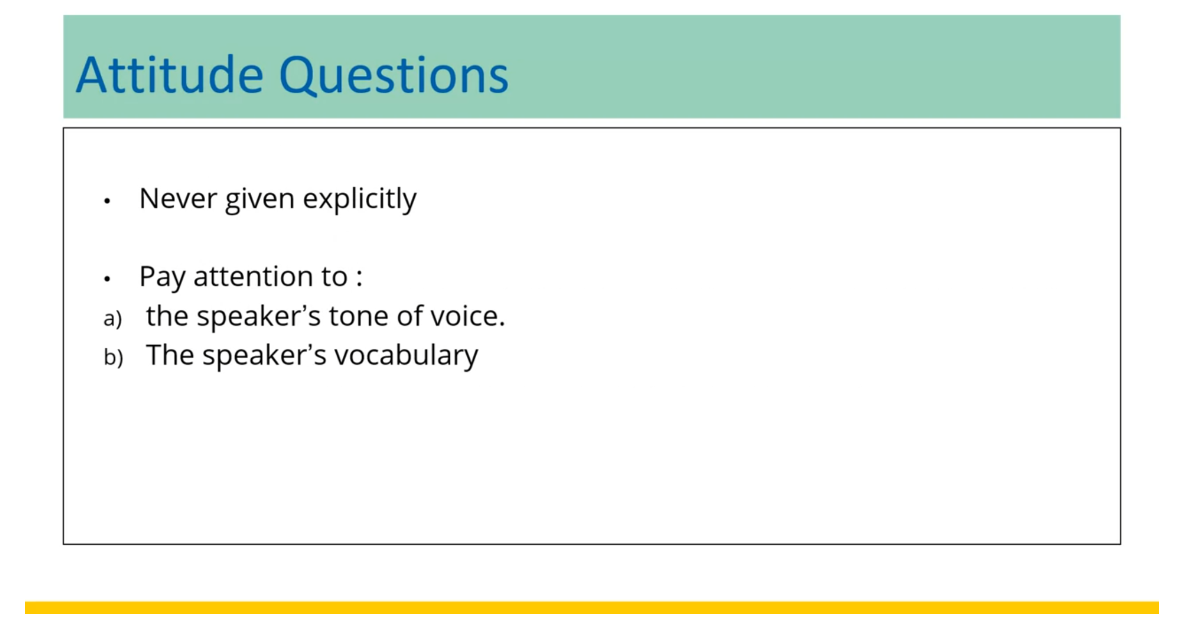
Organization questions. Questions that ask about overall organization
are more likely to be found after lectures,
then after conversations. Refer to your notes to
answer these questions. It may not have been
clear from the start that the professor organized the
information, for example, chronologically, or from least to most complex or in
some other way.
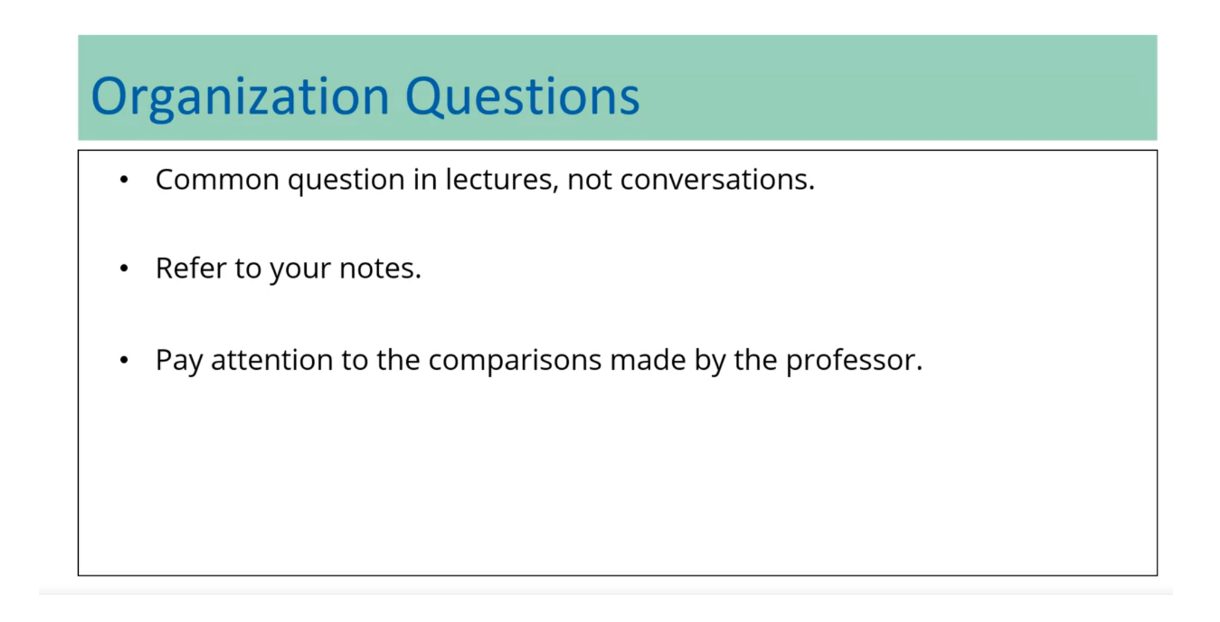
Connecting content questions. As you may remember, these are questions that
ask you to fill in a chart, or table or put events in order. As you listen to the lectures, you need to pay attention to this signal words
or sequence words, clearly identified terms
and their definitions, as well as steps in the process. Also, make sure as
you take notes, use numbers to keep
track of order of events or steps in this sequence. You can circle these numbers
to make them easier to find.

Inference questions. Just like the inference questions
in the reading section. In the listening, inference
questions have answers that are not mentioned in the
lecture or conversation. In most cases, answering this question correctly
means putting together details
from the lecture or conversation to
reach a conclusion. In other cases, the professor may imply something without
directly stating it. In most cases, the answer
you choose will use vocabulary not found in the
lecture or conversation.
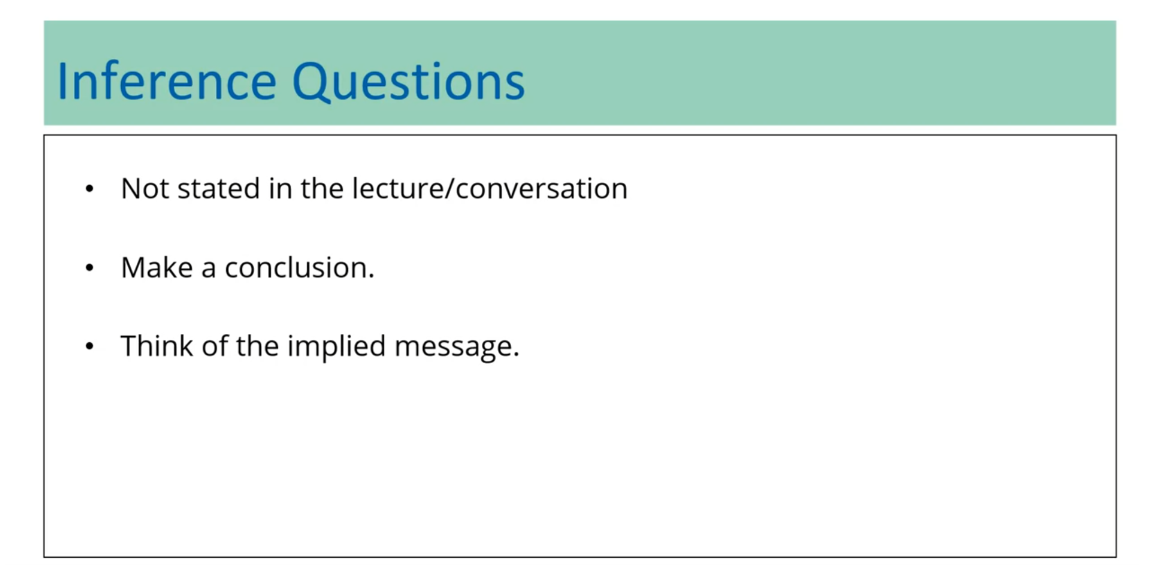
Now it’s time to practice
these strategies. The website, tstprep.com,
you can find some sample questions that are organized based on the
different question types. You will know what
strategy to use to answer these
questions. Good luck. This is the end of part one. Since note-taking is in an essential part of the
listening section of iBT, we’re going to talk
about note-taking in the second part of
this presentation.
iBT Listening Strategies (Part 2)
In the previous presentation, we learn
that you can use different strategies for different question types. But as mentioned, note taking is
very important since some of these conversations and
lectures are pretty long. So here in this module, we’re going to
look at effective note taking strategies. Before we continue, let’s talk
about a very important reminder. You need to try to write your
notes mostly in English. You may be tempted to write notes
in your native language at times. But in fact it’s more convenient to take
notes in English because then you won’t waste any time re translating your notes
back into English as you answer questions. Let’s start looking at the first
note taking strategy writing content words only. That means you want to write down
only announced verbs and adjectives. Because content words are meaningful
words that contain information, they can be people places or action. However, function words are like
prepositions, articles or auxiliary verbs and
they usually have no useful information. Now, let’s practice that in a sentence
insomnia, a consistent difficulty in falling or stained sleep is the most
common of the sleep disorders. Your note can be assured as
this insomnia common disorder. Let’s look at another example. It is not uncommon for people
suffering from insomnia to experience increased levels of anxiety about
their inability to fall asleep again it can be as sure as this,
more anxiety falling asleep. Or a chronic insomnia is almost always
associated with feeling over tired and may be associated with
symptoms of depression. Your note can look like chronic
symptoms over tired depression.
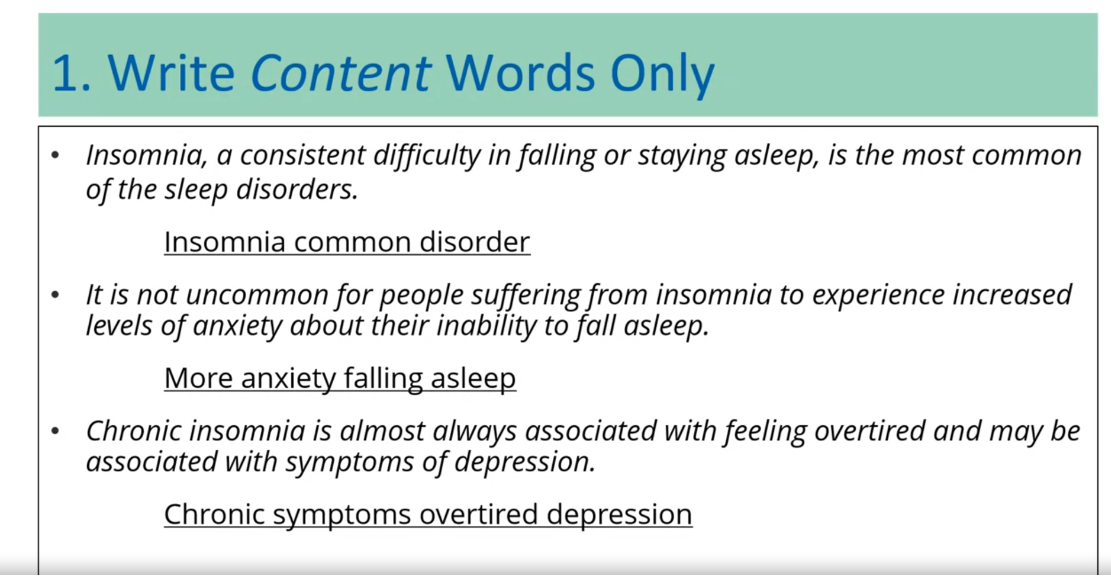
The second strategy that can help
you save even more time is writing consonants only and not the vowels (只写辅音而不写元音), if you remember vowels in English consists
of a, e, i, o, u and sometimes y? And the rest are consonants. Vowels are still common, that you could
write award without event vowels and still understand the meaning. Here are a few examples sleep,
you can just write slp, symptoms smptm and depression, dprs.
Next strategy that can help you save time
when you take notes is using symbols like the chart that you can see here. Symbols are important because
not only do they save time but also increase the amount of
information you can write down. But if you’re absolutely new to using
symbols then do not use all of them at once. The key is to keep it simple. Start with just two or three maybe with arrows first because
they are easier to understand. As you start to feel more comfortable, use more of these symbols in your notes
remember it’s hard to change a habit. You have been taking notes
your own way for years. It will take some time to get
used to all of this information. So take it slow.
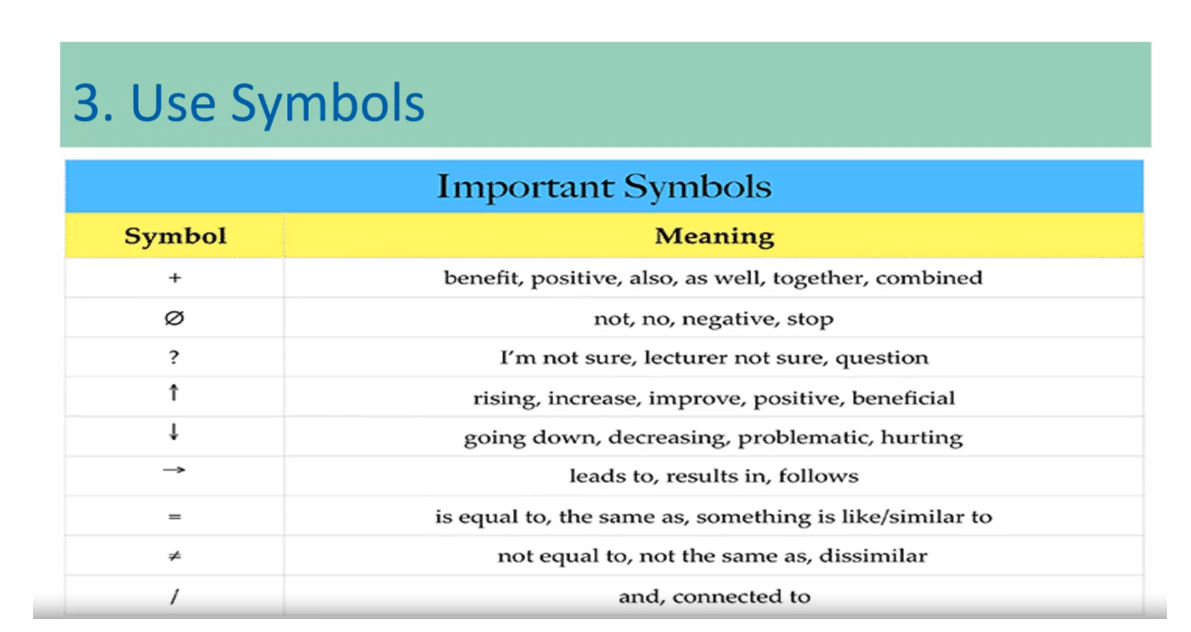
Now look at short handwriting,
definitely try shorthand writing If you want to save time when you take
notes in this example here the person has written content words, consonants
more than vowels and some symbols. This can save you a lot of
time when you’re listening and taking notes at the same time.
Next strategy is using
the two-column layout. This is very helpful if you want to
organize your notes in this example here you can see the note belongs to
a conversation between a professor and a student. This is going to be easy to retrieve information based on who said what.
For lectures it is very helpful if you
can figure out the style of organization. Is it a theory and evidence kind of
lecture in which the professor introduces a theory and provides various
pieces of evidence to support it? Or is it the cause and
effect kind of lecture. In this type of lecture, the focus is on
the cause of something such as an event, discovery or scientific phenomenon and
it’s different effects. Or the lecture might be
steps of the process. In this theory,
the professor introduces a process and the chronological steps involved in it, usually using transitions such as 1st,
2nd, 3rd and so on. Or the lecture can be
a comparison of two things. This is a lecture that focuses
on the similarities and maybe differences of
two different concepts.
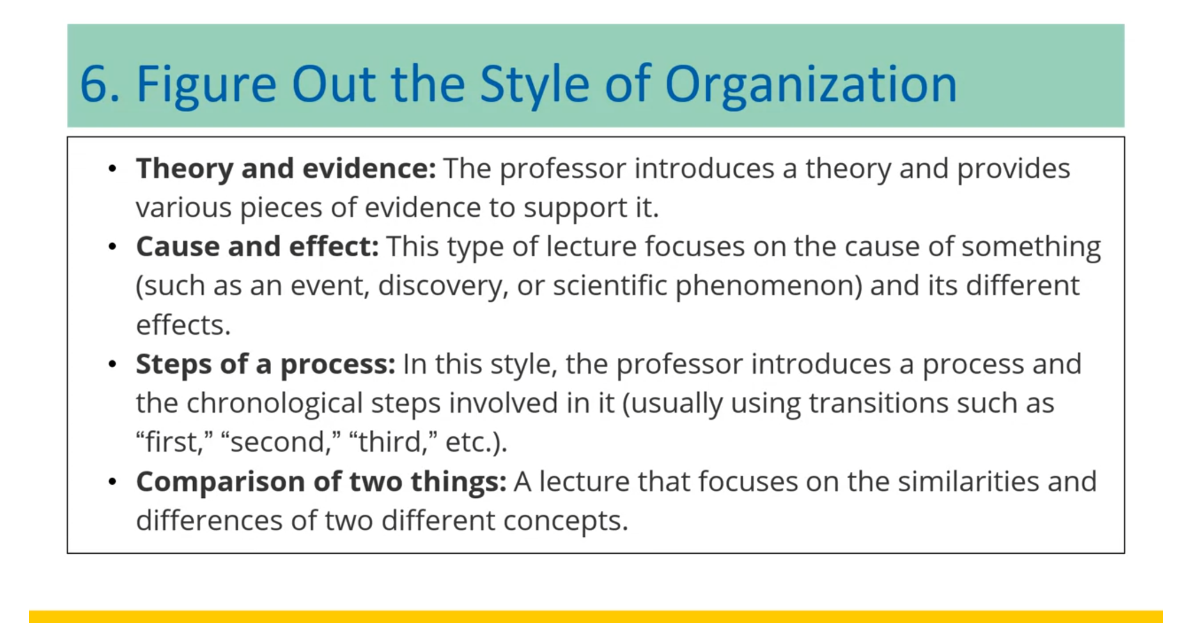
For lecturers, once you’re done, taking
notes, ask yourself these questions to make sure you completely understand
the information in the lecture. Why does the professor say this? What does the professor want
the students to know by the end? Why is this information important? And how does the professor elaborate(详细阐释) on,
explain or illustrate the main idea? This is the end of part 2 of this module. In the next module,
we’re going to talk about speaking and speaking strategies, in particular,
seeing the next module.
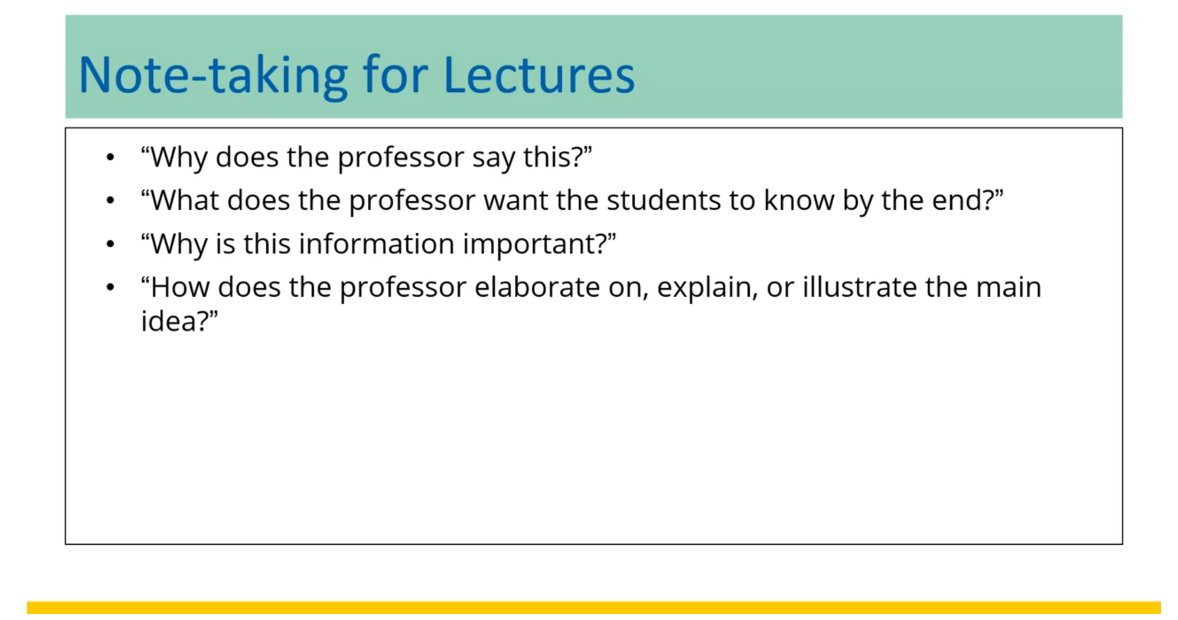
Quiz: Listening Tips & Strategies

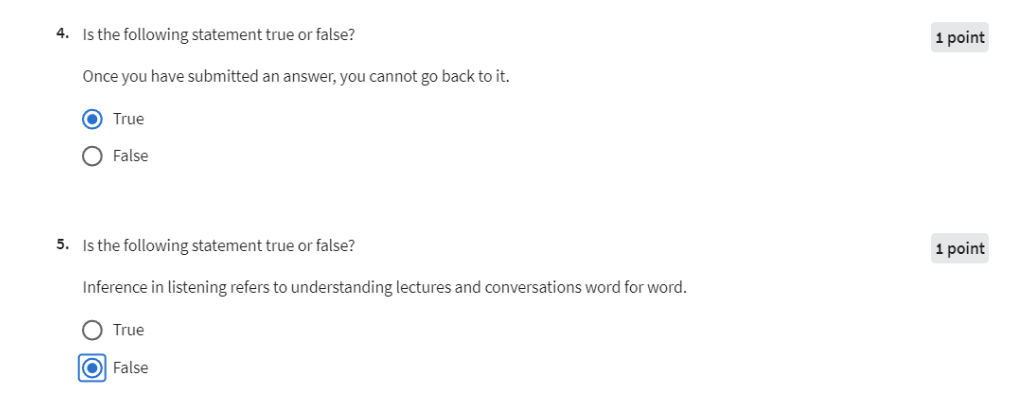
Answer:第三题错误,应该选 5 to 10, 其他都是对的
Week 03: iBT Speaking Tips & Strategies
In this third week, you will become familiar with strategies that will help you answer the tasks that you will encounter on a real iBT speaking section. You will learn how to approach each task effectively and utilize your preparation time as well as speaking time efficiently.
Learning Objectives
- Learners will become familiar with some effective speaking strategies.
- Learners will practice some strategies that will prepare them for iBT speaking questions.
iBT Speaking Tips & Strategies
The iBT Speaking Section is designed to measure many skills such as vocabulary, grammar, pronunciation, task development, and more. Therefore, preparation is key. So, take note of these top tips for TOEFL speaking questions.
Tip #1: Take Notes
It may be a speaking test but note taking is key. As you have learned, only the first task in the speaking section is “independent.” The rest of the tasks require you to read and listen as well. TOEFL lectures are information heavy, so jot down the most important information as you listen. For note-taking strategies, go back to Course 3, Module 2 and review the lecture on note-taking tips.
Tip #2: Prepare a Template
You may not know what question or topic you will be given, but you can plan some aspects of your responses in advance. Prepare a template with useful phrases for introducing your opinion, linking to a second idea, mentioning a contrast, and arriving at a conclusion. To review the templates, go back to Course 2, Module 1 and 2.
Tip #3: Do Not Memorize Sample Answers!!
This should be obvious, but when you work and practice with templates and sample answers, it may feel it is easier to memorize some high score samples. Remember that TOEFL Speaking templates can be useful when you prepare for the test so it is wise to become familiar with the questions, but be extremely careful. Using memorized sentences on the TOEFL exam is considered cheating and your score may be cancelled.
Tip #4: Be Clear
Your goal in this TOEFL section is to speak with a natural, steady pace more closely to that of a native English speaker. This will take dedicated, regular practice that you start and continue well before you take the test. In your practice, monitor that you avoid 1) rushing with your words while speaking and 2) laboring to find the word you want. Either of these errors will lower your score on the test.
Regular practice will dramatically improve your speaking. Daily, choose two or more speaking tasks from TOEFL speaking-sample sites such as TOEFL Speaking - Sample Questions and Answers (2021), jot down points you will include while speaking, then using a timer and recording device, speak confidently as you fill the time. Make friends with the various tasks and enjoy this practice since, like weight training in the gym, it will build your speaking confidence and strength. As you practice, listen to your recording after each speech, and note what you hear. Have you provided examples of the point(s) you are making? Have you included information from both the listening and reading material in integrated tasks? Are you using transitions to lead your listener through your reasoning? Do you limit pauses and hesitations? Have you checked off the other best-speaking-tips that you have studied? Then, practice again.
Tip #5: Get Creative
While the TOEFL may be a test, it’s not a test of absolute truth. Whatever question is thrown at you, remember that you can answer however you like, as long as the details you provide support your choice. So, try to prioritize showing off your English over expressing your real opinion. In other words, if you find agreeing to a side in an agree/disagree question easier, go ahead and make up your answer even though in reality you disagree with that.
Tip #6: Practice Accents and Pronunciation
Remember that the TOEFL tests your English comprehension across accents, often featuring recordings of native speakers with accents from across the UK, Australia, the US and New Zealand. So, as mentioned in the previous modules, it is helpful to engage with media from a variety of English accents.
Regarding your speaking accent, you are not expected to sound like a native speaker. However, you need to speak clearly with correct pronunciation. When you practice speaking, record yourself and check your answers for word stress, sentence stress as well as intonation.
Tip # 7: Show off your Grammar
You should not be limited in your grammar in any way when you speak. Therefore, you should use a combination of longer and shorter sentences. In addition, you should show syntactic variety. This means you should try to use simple, compound, and complex sentences in your independent and integrated speaking responses. For helpful grammar tips click here:
[Sentence Types: Simple, Compound, Complex, and Compound-Complex](https://www.lamission.edu/learningcenter/docs/asc/worksheets/Grammar/Sentence Types.pdf)
Tip #8: Focus on Yourself
The TOEFL test can feel a little stressful as you record your answer in a room with other people on test day. Block out the other candidates and close your eyes if it helps you to focus.The key in this kind of practice is being able to feel confident and prepared. If you feel you have prepared yourself for the test, chances are you will be able to control your stress. However, if you feel you have not practiced for the test, you may feel nervous.
Tip #9: Practice with TOEFL Speaking Tests and Samples
The fastest way to learn is to take as many sample tests as possible and to listen to sample answers. Try to listen to high-score sample answers and pay attention to the vocabulary choices, grammar, pronunciation, and overall task development.
Tip #10: General Tips
On the main webpage of ets.org there are some useful tips and strategies that will help you practice speaking in a structured way.
Improving Your Listening Skills (For Test Takers)
iBT Speaking Strategies (Part 1)
Welcome to Course 3, module 3. In this module we’re going to talk
about speaking strategies for iBT. And in the first part we’re going
to look at these strategies in the independent task only, let’s begin. As mentioned before, you’re going to
have only one independent speaking task, for this task you’re going to have only
15 seconds to prepare your answers and you’re going to have 45 seconds
to record your answers.
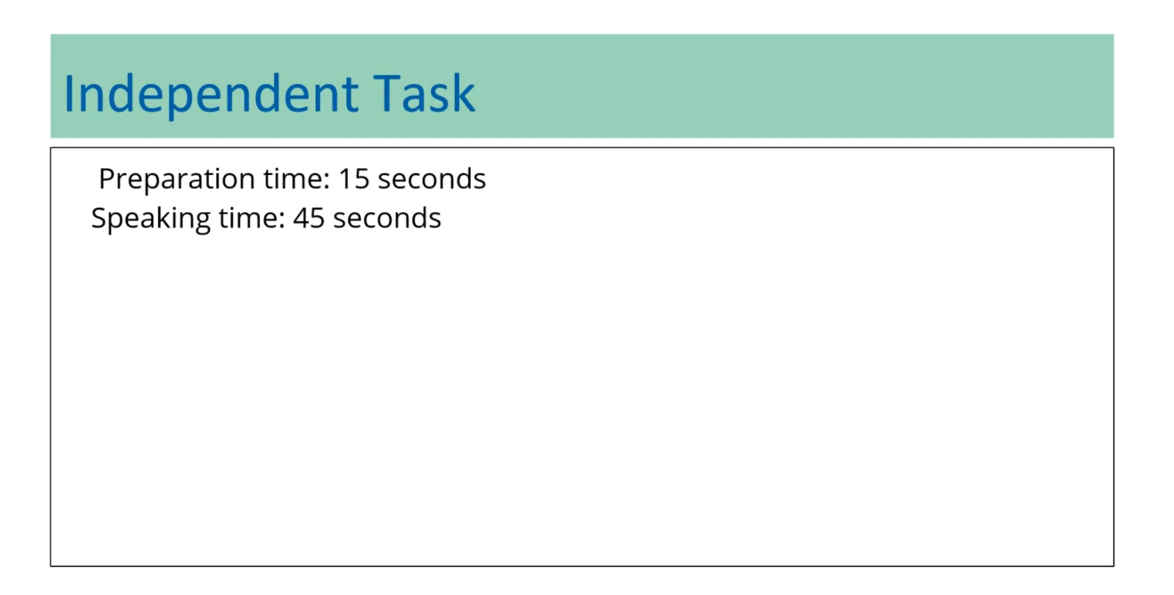
The preparation time or the pre-speaking
time that you have is very limited, 15 seconds is not a long time so
you need to use this time wisely. First step can be analyzing the prompt, then you need to decide
on your answer third. You Need to choose 2 to 3 reasons and
you need to have some notes to help you speak throughout
the 45 seconds that you have.
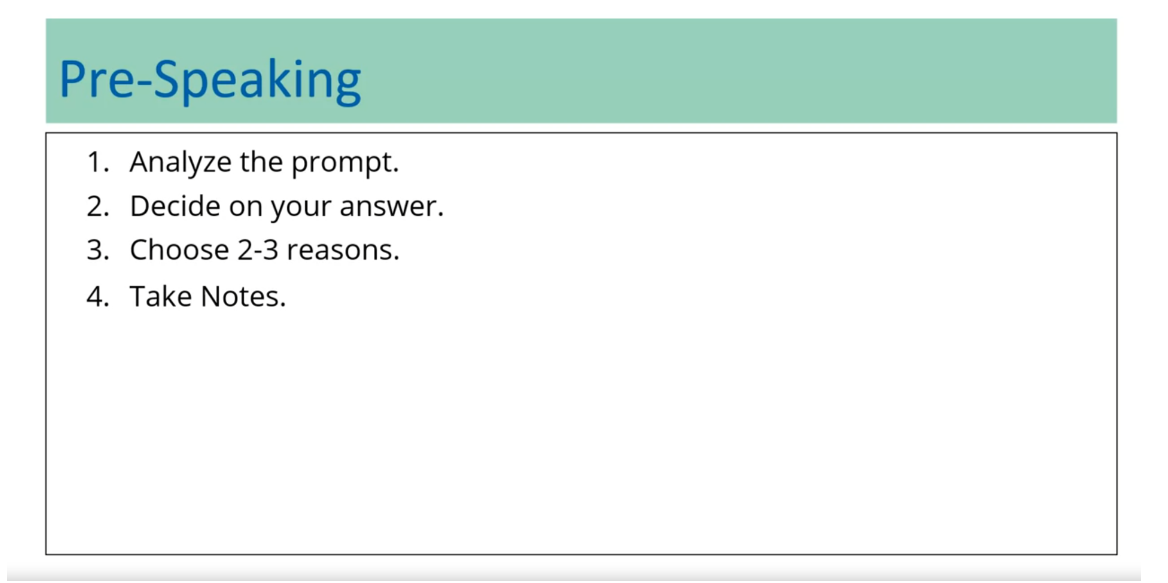
Another strategy that can help
you save time in preparation is expecting the language that you can use
when you speak to answer the question. The questions that appear in
the independent task either ask you about your opinion, your preference,
whether you agree or disagree with something,
they can be about some general topic or it might be about two opposite or
contrasting ideas.
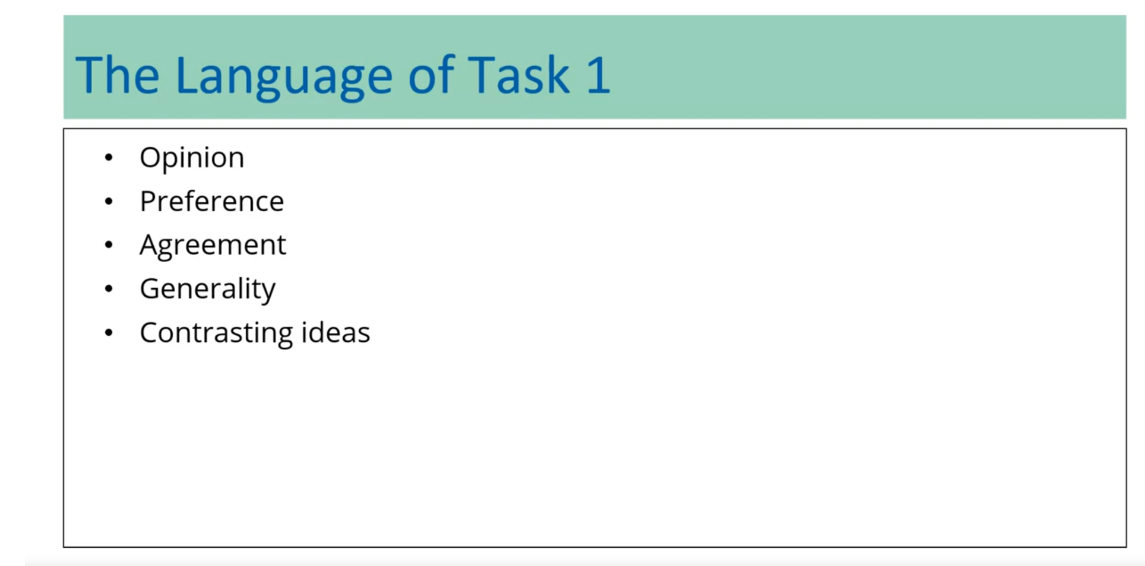
You may recall these kinds of sentence
structures from the templates that we talked about in course number two,
but let’s look at them specifically, depending on the idea and
the kinds of tasks that you get. If you have an opinion question,
you can answer the questions using these verbs or adverbs,
you can say, I think I feel or I believe that and
then completed with a sentence, a small town is a better place to
raise children than a big city. Or you can start by stating your opinion
with an adverb personally, I believe that, and then you can write a complete sentence
just like the previous sentence or you can say in my opinion and then complete
that with another complete sentence.
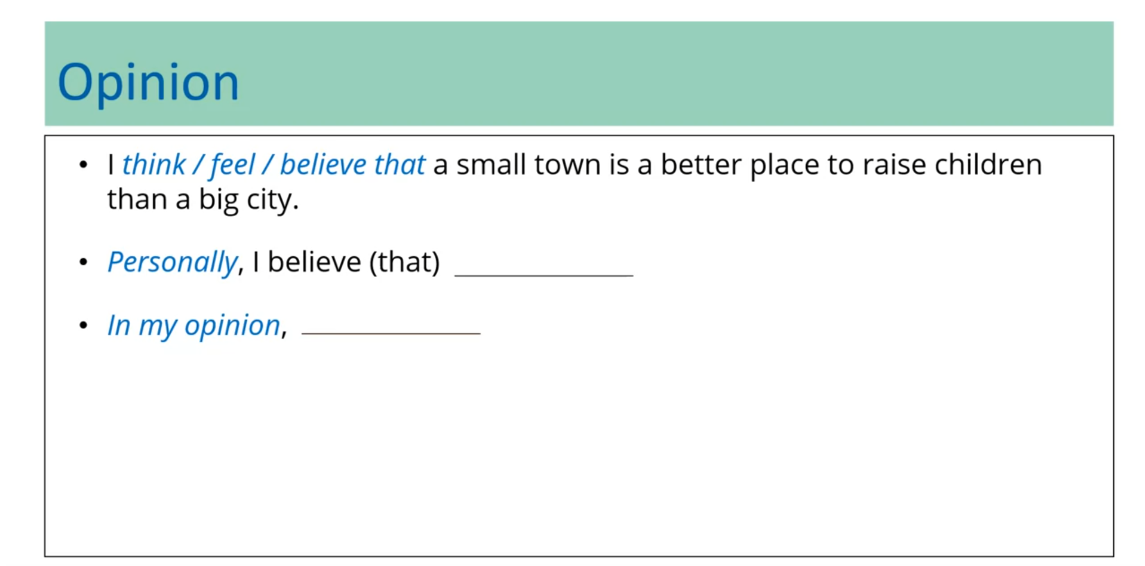
If the question asks you
about your preference, you can use verbs like enjoy and
prefer, if you choose to use enjoy remember the verb that
follows need to be used with ing. In this example I enjoy living alone,
so I would not want a roommate, enjoy plus living or
if you choose to use prefer, the second verb can be used with two or
with ing. You can say I prefer to
live in an apartment or I prefer living in an apartment.
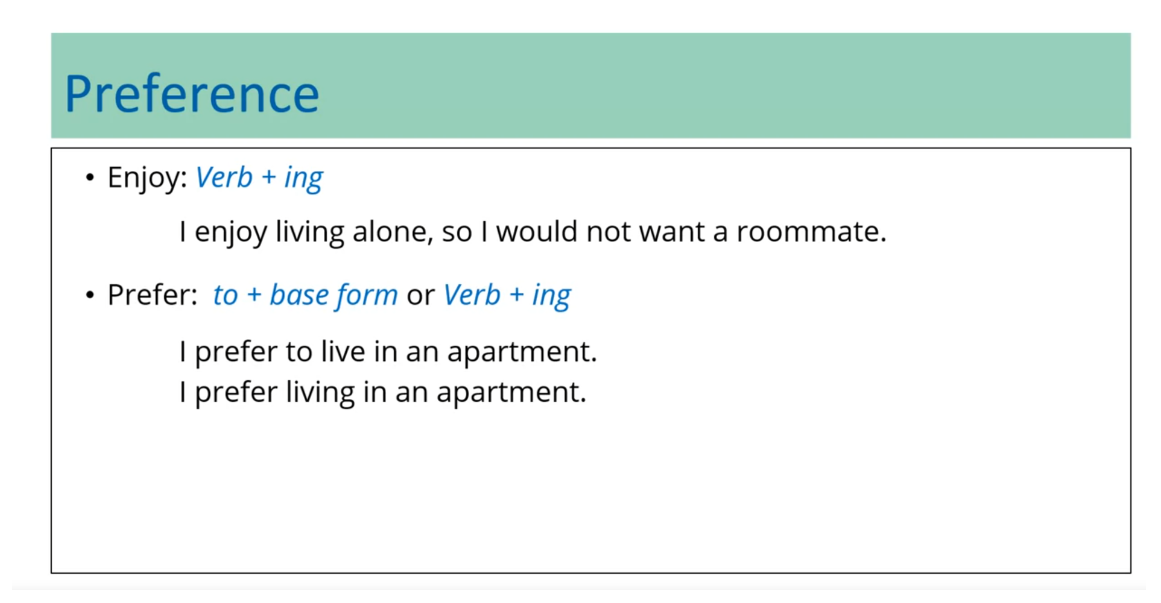
If the speaking question asks you to
agree or disagree with something, you have several options,
two of them are mentioned here. One, you can use agree with and
then a non, example, I agree with those people or you can use the verb agree plus that,
plus a clause(从句). If you remember a clause has a verb and
subject, for example, here you can say I agree or I disagree with the idea that
college degrees are important.
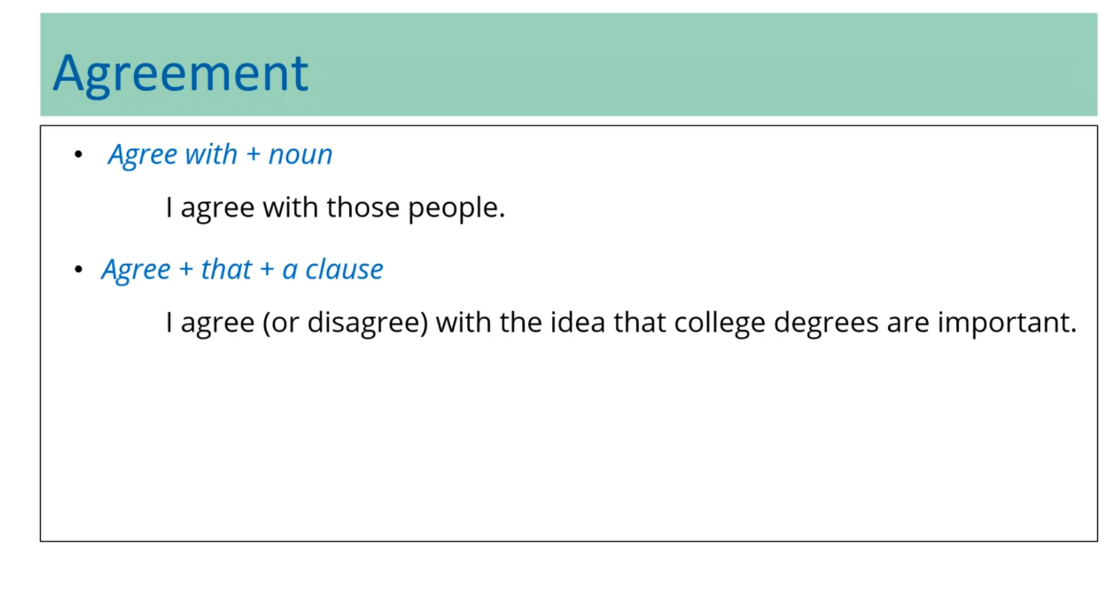
If what you’re trying to say is about
something general or a general idea, you can introduce that with this phrase
in general and then completed with a sentence, in general, I think
that some celebrities are overpaid. Another approach is using
an adverb instead, for example, you can say I believe that first
impressions are generally quite important or you can use another
phrase that has the same meaning, on the whole, I enjoy traveling
with friends rather than by myself.
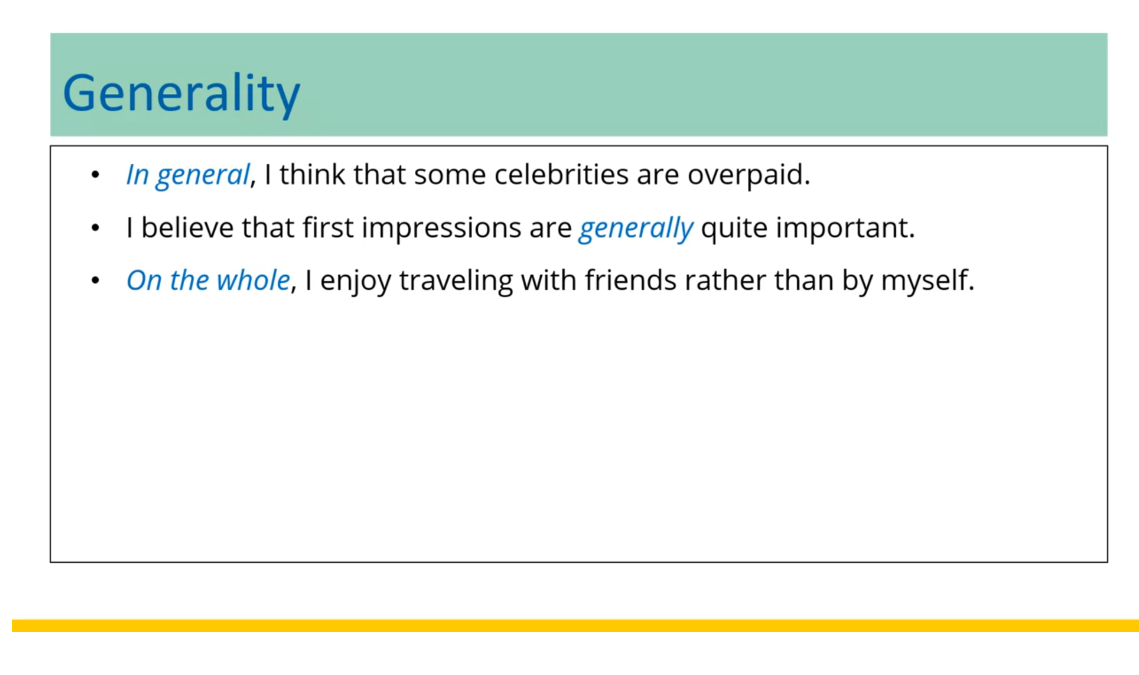
If you want to present contrasting ideas,
then you can use the transition word after presenting the opposite
opinion, here is an example. Many people like living with a roommate,
however, I think living without
a roommate is much easier.
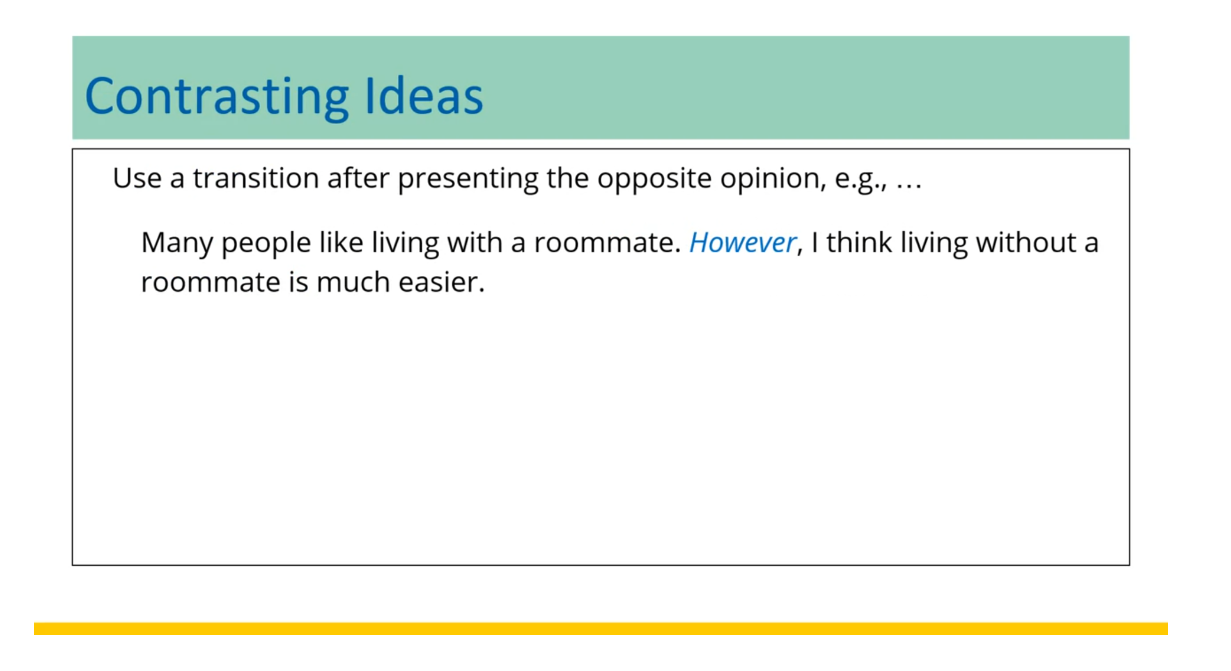
This might sound so obvious, but
you need to have good reasons and examples to improve your
speaking score and this task. One big mistake that some candidates make
is they simply speak with fluency and good vocabulary, but the reasons are not
strong enough to support their choice. When you respond to a task like this,
you should try to give at least two reasons for your choices,
also you need to make sure that these answers are not too general and
they are not too big to understand. Also when you use examples, make sure that you make some of them
personal related to your own experiences.
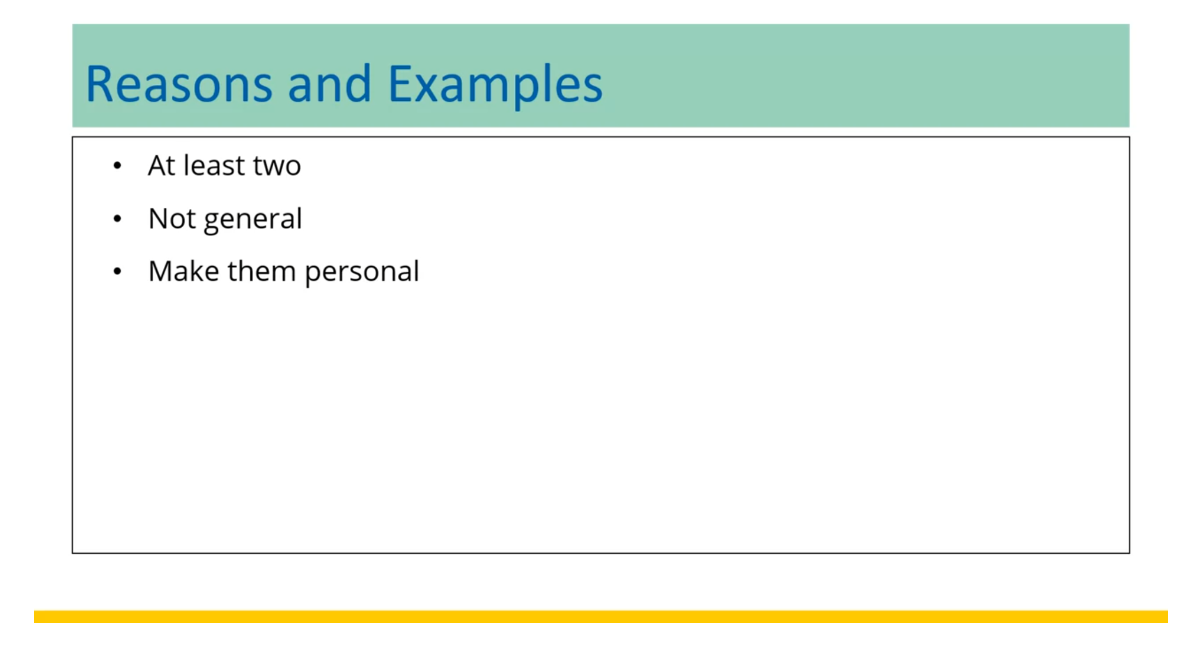
Some iBT candidates wonder if they
need to have a concluding sentence when they answer task one. Well in the 45 second response, you do not
really need to have a formal conclusion, however, if you still have 10 to12
seconds and you’re wondering what to add. You can definitely add a summary or concluding sentence at the end
instead of just pausing and waiting. This is the end of part one of this
module, in the second part we’re going to look at some strategies regarding
the integrated speaking tasks of iBT.
iBT Speaking Strategies (Part 2)
Welcome back. In the second
part of this presentation, we’re going to look at
some strategies regarding the integrated
tasks. Let’s begin. As mentioned in course 2, for this task, you will
read an announcement. Then you will hear
a conversation in which two students
discuss the announcement. Sometimes this task is
called campus question. This conversation lasts from 60-80 seconds and you’ll
be able to take notes. The best strategy
here is identifying exactly what the proposal
in the reading section is. Once you identify that, make sure you understand
the reasons for it. Are there reasons against
the proposal or not?
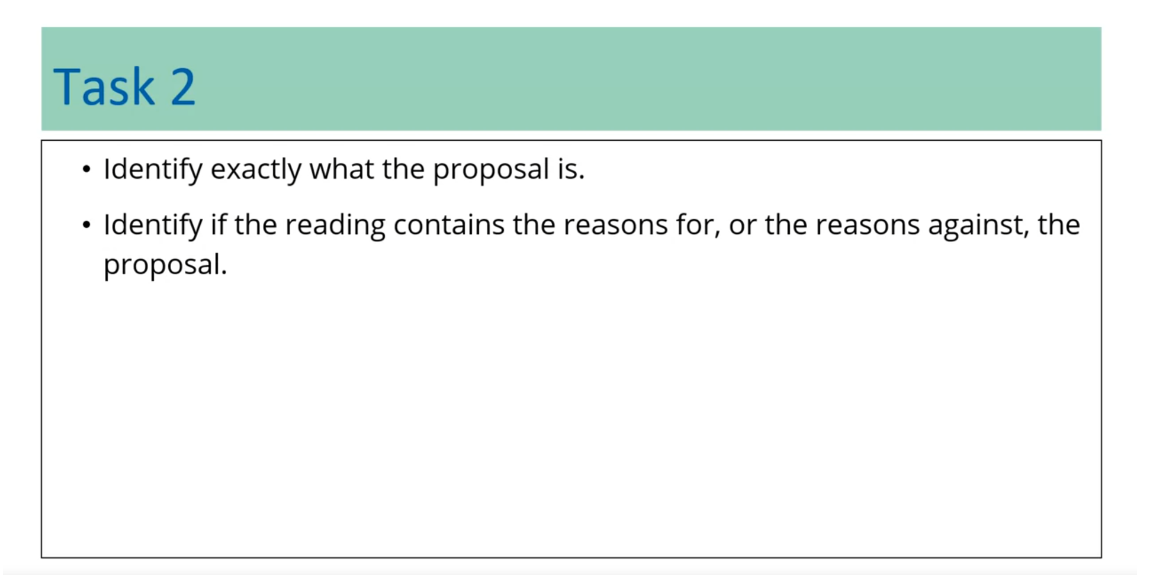
Since their reading section
or the announcement is followed by a conversation
between two speakers, almost always if female
voice and a male voice, you need to have very
organized notes. By dividing your listening
column into two sub columns, you can specifically note what the female speaker and the male speaker are
saying to each other. The third task in the speaking section is that lecture instead
of the conversation. First, you are going to read and then you’re
going to listen to professor explaining something
related to what you read. It’s very important to use
a template so you can have your notes from the reading and the listening side-by-side. First, write the main
idea from the reading, as well as the points
that are mentioned. Then contrast those points with what the professor mentions and the way he defines the
terms and concepts.
The last task in the
speaking section is listening to a lecture and
summarizing the main points. You’ll have 20 seconds to
prepare your response, and you’ll have 60 seconds
to record your answer. The best strategy is having
great notes and also having a template with
these features: topics, citation, lists, and examples. We have talked about
these templates in course number 2, module number 2.
Besides developing your answers, you need to also think
about the way you deliver your response and fluency
is an important part of it. You don’t want to speak
too fast or too slow. Let’s try and check out how your speed or your fluency is. You should be able to speak about 130 words in 60 seconds. You have 60 seconds
to try to read this paragraph out
loud. Let’s begin.
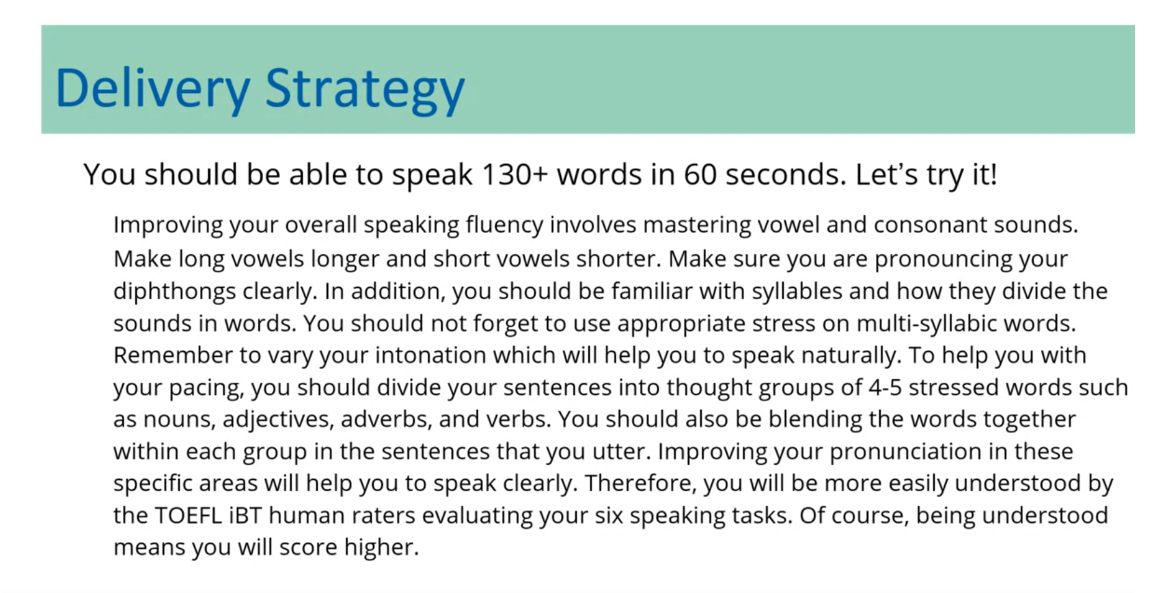
Besides practicing, developing ideas and fluency
or delivery of response, you need to also improve
your language use. Think about the variety of
vocabulary that you use. Do you repeat the same
vocabulary over and over again? Do you use too many
simple sentences? Do you have enough
compound sentences? Do have complex sentences
in your response? Do you ever use a combination of compound or complex sentences?
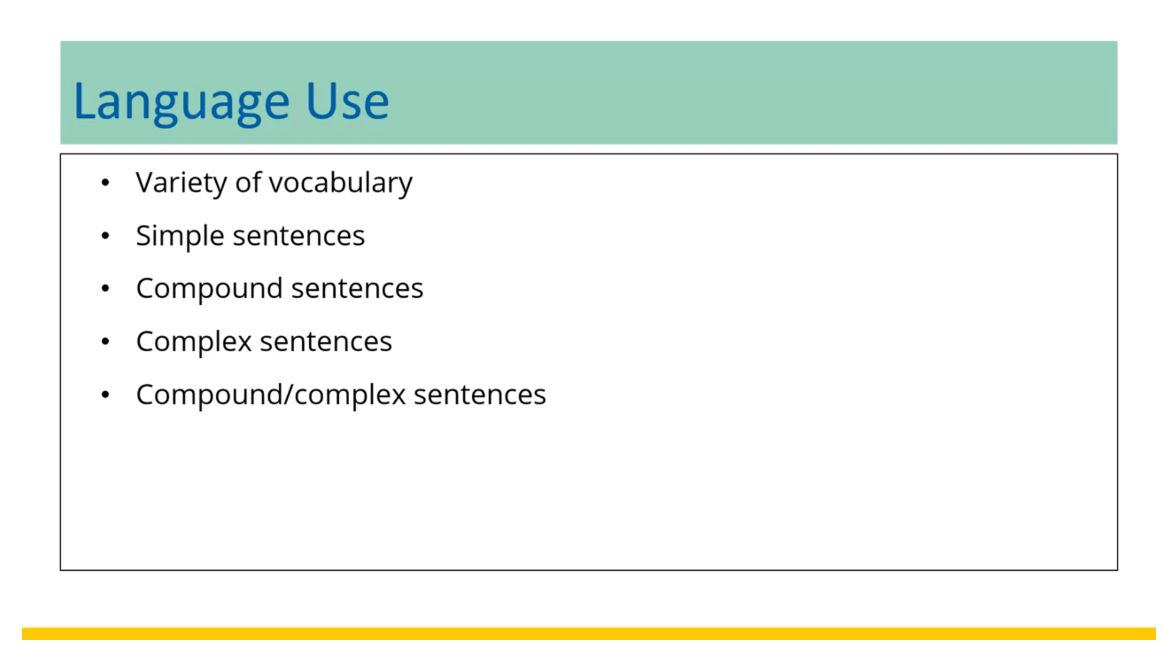
When you practice vocabulary
for your speaking tasks, make sure you’re able to
use varied vocabulary and you do not use and repeat the same word over
and over again. Also, make sure you have enough academic words
in your responses. Finally, it’s a
good idea to learn some idioms you can
use in your answers.
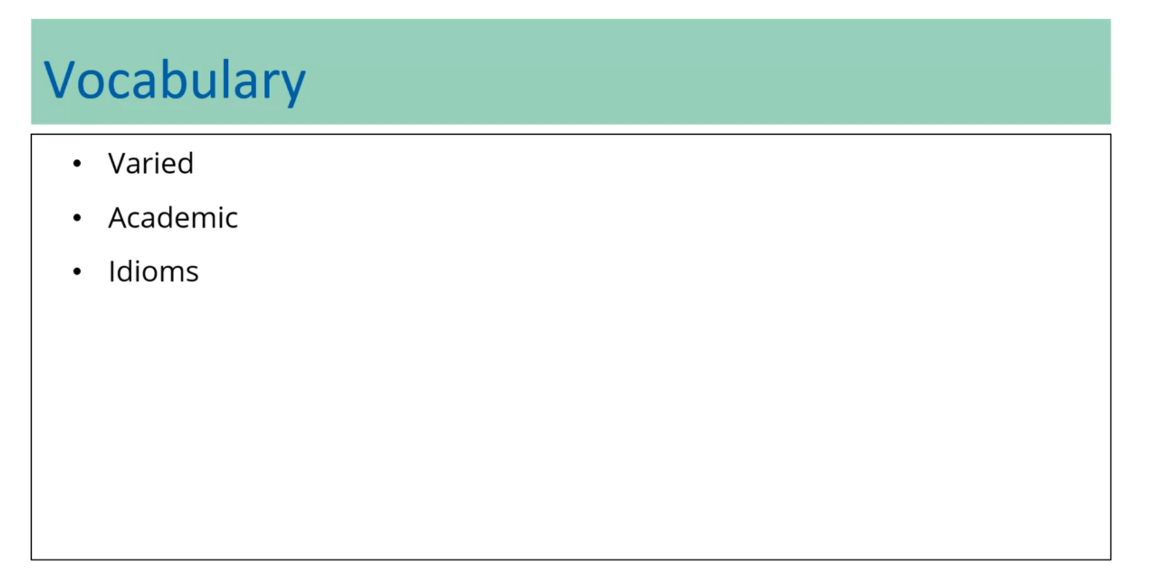
Is completely acceptable to have simple sentences in your answers. Simple sentences have one
subject and one verb. They are typically used
when you want to state the main point of the reading
or listening passage. For example, the reading passage introduces an economic
concept called inflation. As you can see here, you have one verb, introduce.
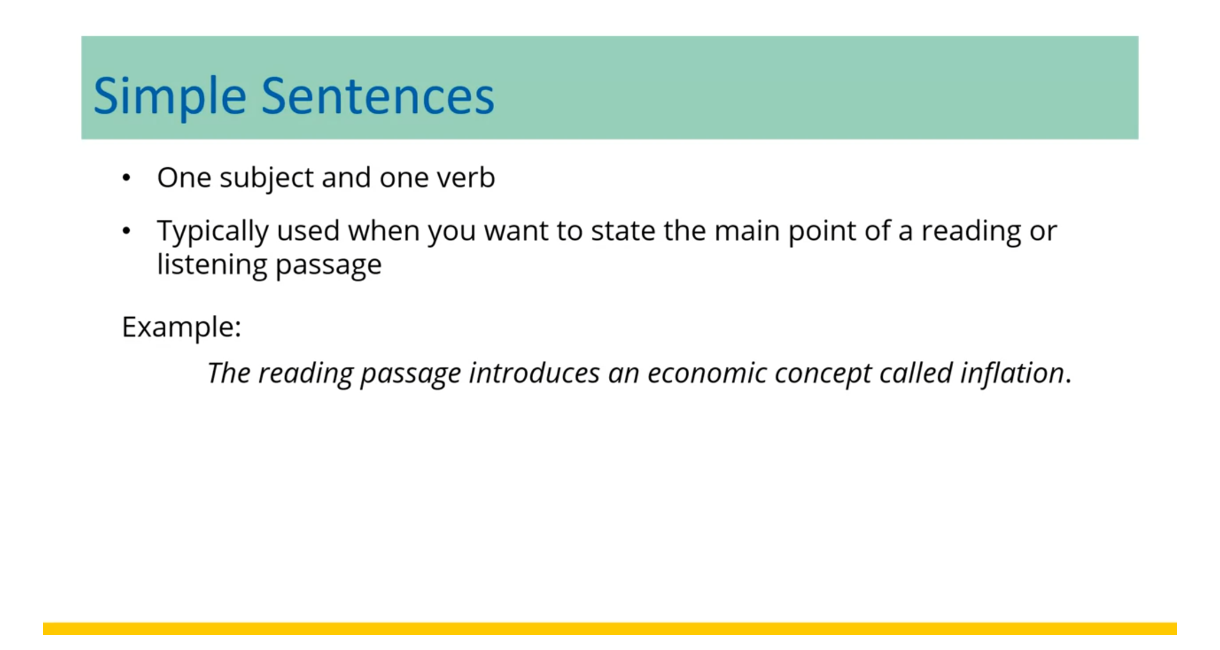
Try to use some compound
sentences as well. Compound sentences are
two independent clauses joined by a conjunction such as, and, but, or, so, yet, for. This type of sentence includes two subjects and two verbs. It helps you introduce the most important points in reading and listening passages. Here’s an example. The reading passage introduces an economic concept
called inflation, but speaking passage discusses
the idea of deflation.
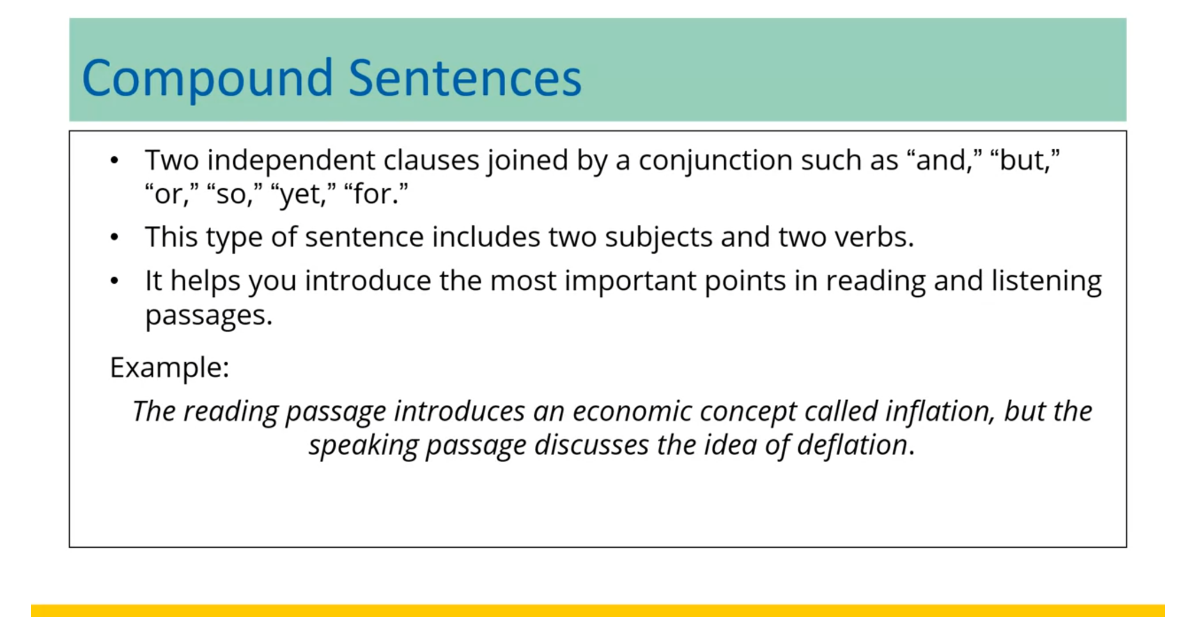
Now you can show
off your grammar by using some complex sentences. That means a dependent clause, such as a noun, adjective, or adverb clause, plus an independent clause. Here are some examples. Complex sentence
with adverb clause. Inflation, as the reading
passage suggests, refers to the increase of
goods and services over time. Complex sentence with an
adjective and adverb clause. For example, bats,
which sometimes have difficulty finding their young when they return to the cave, feed other baby bats
not related to them, informs this speaker
in the lecture. Complex sentence
with noun clause, the speaker in the
lecture asserts that most terrestrial
animals have protective mechanisms
to make it more difficult for predators
to find and eat them.
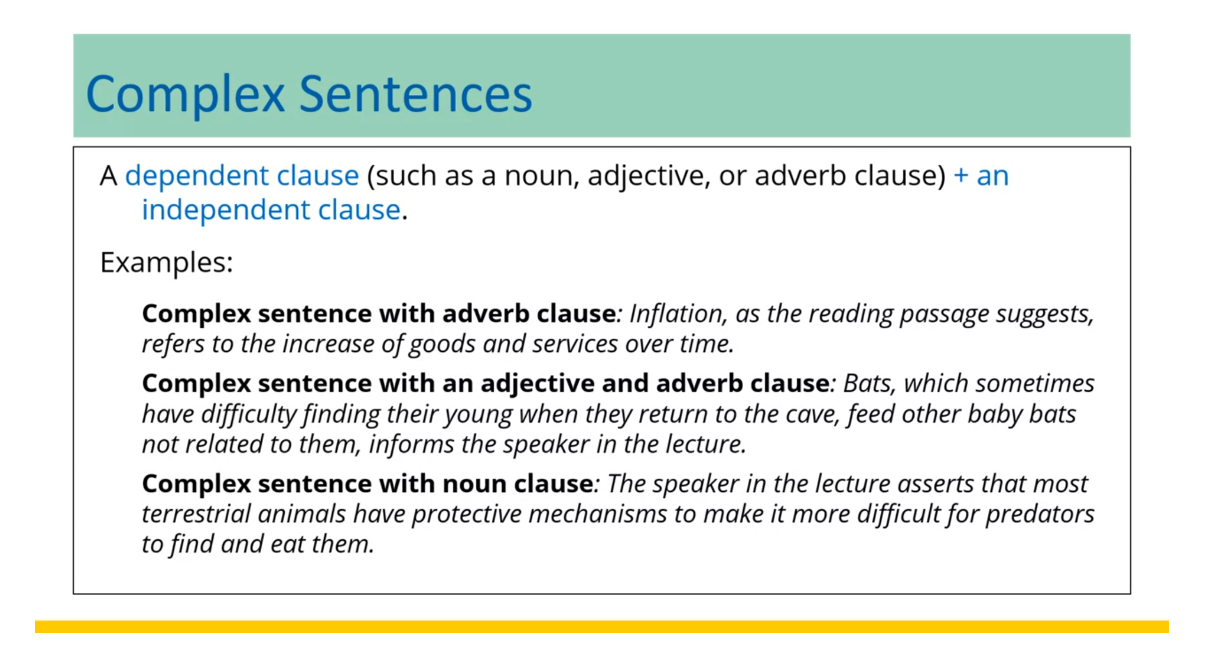
Also, it’s possible to use some compound-complex
sentences. That means compound
and complex sentences together that can make
your sentence pretty long. Here’s an example. The author in the
reading passage who argues that businesses
can be successful, asserts that
employees should read all documents in their entirety, that they should
attend all meetings, and that they should skip the steps of the writing process, and the speaker in the lecture contradicts those
three assertions. This is the end of the
second part of this module. In the next module, we’re going to look at some
writing tips and strategies.
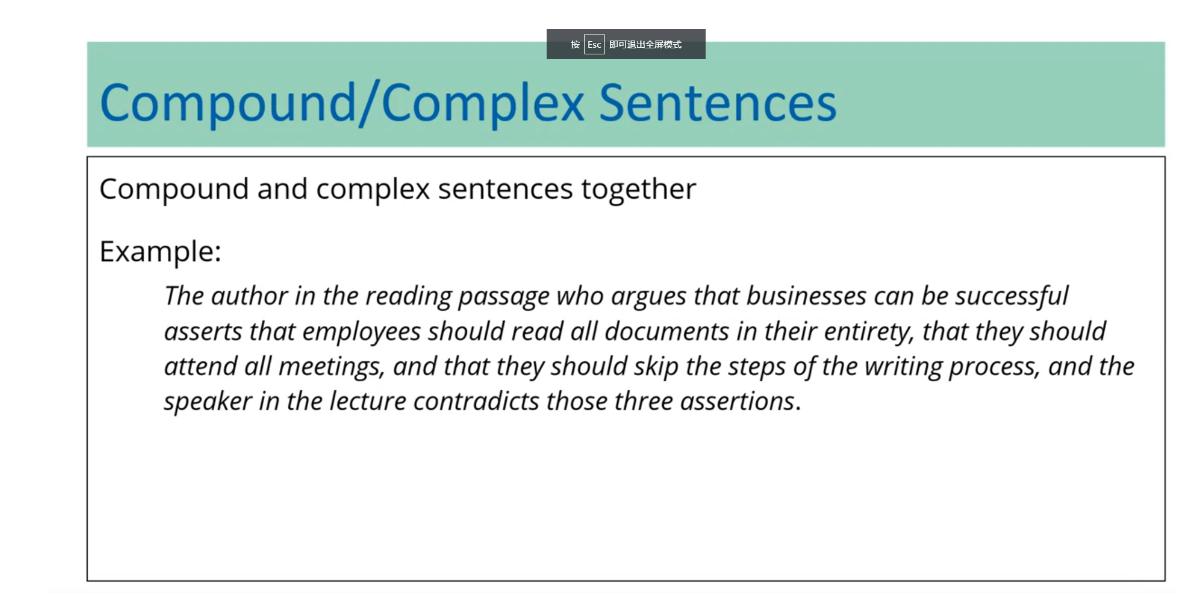
Quiz: Speaking Strategies & Tips
My choice
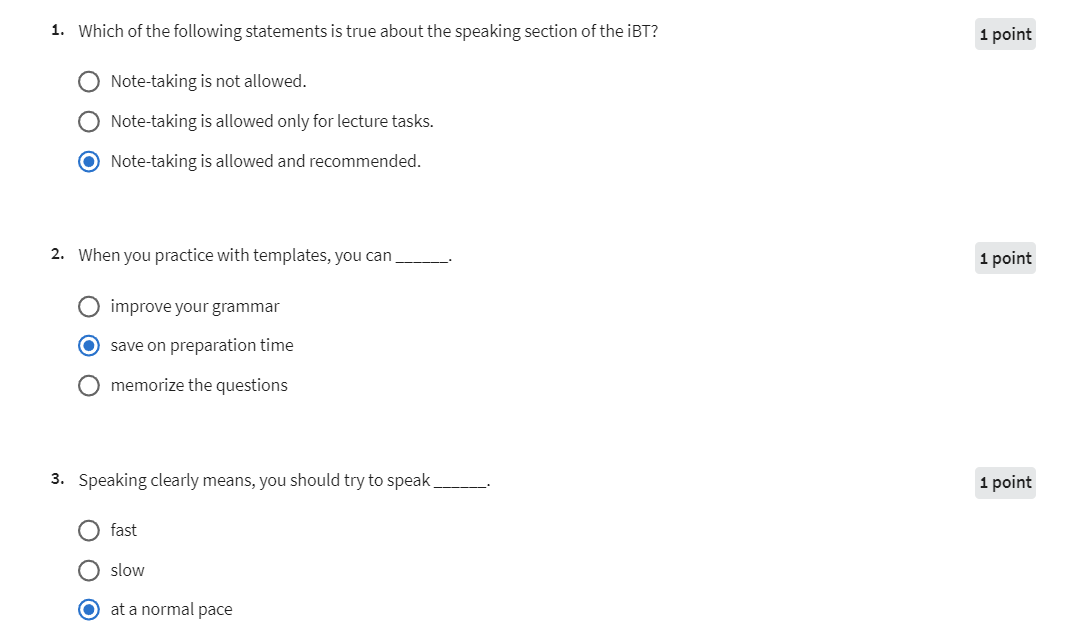
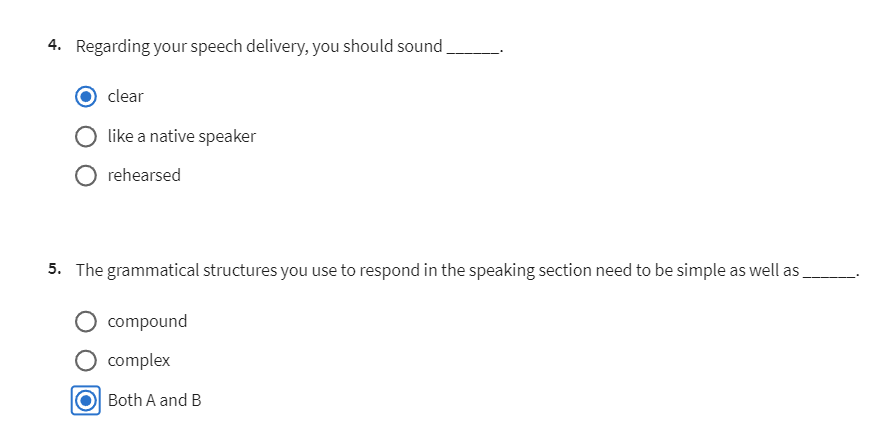
Answer:
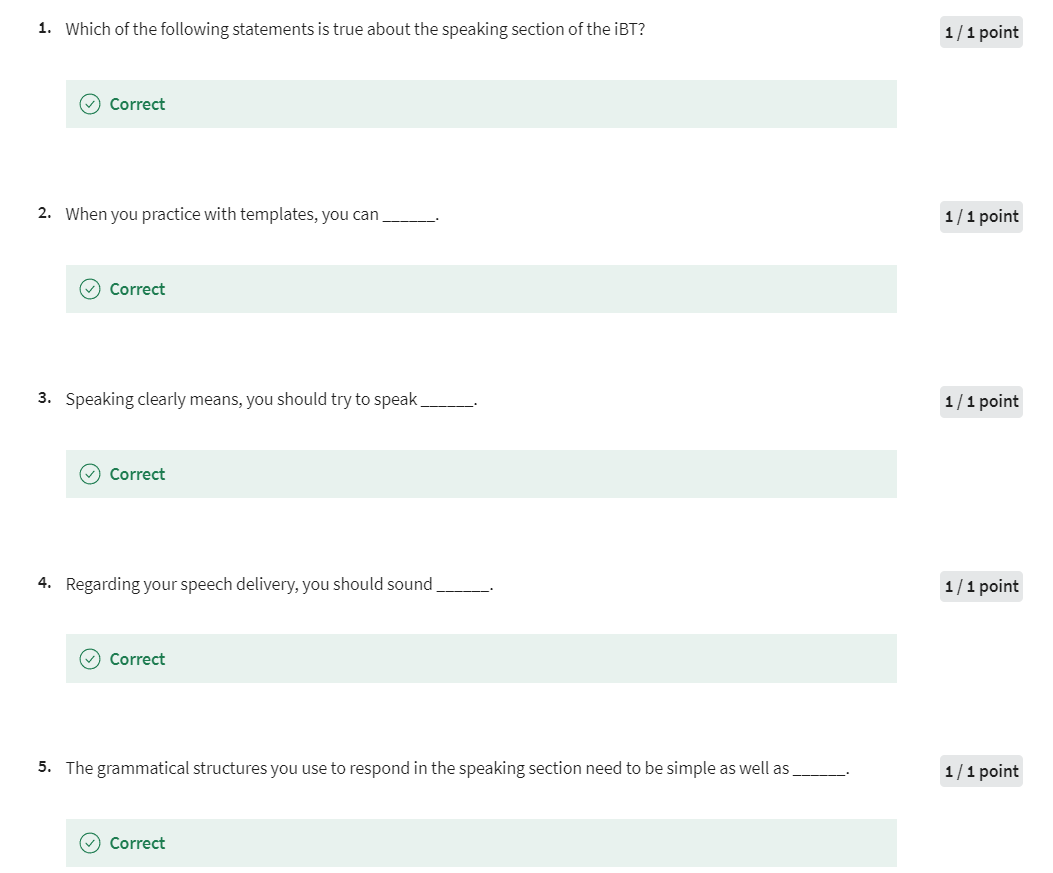
Week 04: iBT Writing Tips & Strategies
In this fourth week, you will become familiar with strategies that will help you answer the tasks that you will encounter on a real iBT writing section. You will learn how to approach each task effectively and utilize your time efficiently.
Learning Objectives
- Learners will become familiar with some effective Writing strategies.
- Learners will practice some strategies that will prepare them for iBT writing questions.
iBT Writing Tips
The Writing Section is the last section in TOEFL iBT. It tests your ability to write in standard academic English. The TOEFL iBT Writing Section has two tasks: an integrated writing and an independent writing. This week, we are going to explore some tips and strategies that can help you write more effectively and get a high score.
Tip #1: It’s Key to Keyboard
Practice writing in English using a computer keyboard since TOEFL iBT responses can only be typed. It is critical to have keyboard writing skills for the test if you are going to use your time most wisely. You can check your typing speed at www.typingtest.com. This will tell you if you are fast enough or if you need typing practice. If this website rates your speed as low, you need to devote time to improving your speed. Try taking some online courses that teach you how to type fast using both hands and all the fingers, also known as “touch typing.” One helpful site for improving your typing speed is https://www.typing.academy/
Tip #2: Expand Your Vocabulary Step-by-Step
Keep a list of new words you encounter and schedule regular review time to practice these. Also, include these new words as you speak and write.
In your writing practice, use wide vocabulary and grammatical patterns. Stretch yourself. You will impress iBT raters when you reveal this vocabulary and various grammar structures.
Tip #3: Practice Organizing Your Writing
Obviously, your time is very limited on the iBT test. Before starting the actual writing, take two-to-five minutes to create an essay outline. Yes, the time will be ticking, but a good outline will save you time while writing and make it much easier in the end. On your outline, include two-to-three main phrases per paragraph capturing the paragraphs’ major ideas and a few examples and supporting details. Do not write full sentences here. Instead, jot down some words and phrases that will guide you as you actually write the essay and provide additional information that will lead to a well-organized, interesting essay.
In your writing practice, actively include transition or linking words to move between different ideas, compare and contrast points, add information, provide examples, etc. You know linking words including for example, furthermore, for instance, in addition, on the other hand, first, second, to sum up, etc. Open the following link to see a graph of central signal words along with explanations of when to use them, and keep the graph open while you’re doing your important writing practice: GRAMMAR WORKSHEET MORE TRANSITION SIGNALS
Tip #4: Practice Spelling
There is no auto correction available on the iBT test. This means that 1) mistakes will not be underlined in red, and 2) spelling mistakes will not be corrected for you. Therefore, it is up to you to notice any spelling mistakes as you type, correct them immediately, and move on. It is very helpful to practice spelling beforehand and not to spend your precious time in the test trying to remember how to spell a certain word.
Tip #5: Manage Your Time Effectively
At the beginning of your practice, it may be difficult for you to plan and write a standard essay in 30 minutes, but practice will certainly help you achieve this. The best way to practice improving your time management is to use five minutes to make your outline and then to time each of the approximately four paragraphs you write. Ideally, have your goal to spend no more than four-to-five minutes on each paragraph and to save a little time at the end to review what you have written.
Tip #6: Remember Summarizing and Paraphrasing
We learned that summarizing and paraphrasing are important skills for listening and the integrated speaking task. The same is true in the integrated writing task. Shorten and simplify what you read and hear (summarize it) and restate it in your own words (paraphrase it). As reviewed in the previous modules, you will automatically summarize the material through your effective note taking, and as long as you try to reword the information in your own words, you will be on the right track.
Tip #7: Use a Variety of Sentence Structures
You may have already been able to show off your grammar in the speaking section. However, the writing tasks require you to use another level of grammatical structures. In these, you need to use a variety of verb tenses, compound and complex sentences, adjective and noun clauses, and so on. Also, transition words play a very important role in presenting your ideas in the most organized way. We will explore this subject in the lecture part of this week’s lesson.
Tip #8: Monitor Your Progress
Ask a friend, tutor or teacher to evaluate your practice writings based on TOEFL iBT writing rubrics. For best feedback on your overall accuracy, also take sample tests from ETS which are scored by professional TOEFL iBT raters. Finally, read various high-score essay samples and analyze them to understand the factors that contributed to their high score. What elements can you incorporate into your own writing?
Tip #9: General Tips
There are some wonderful tips and strategies from ETS on the following link. They are great for both writing iBT essays and academic essays in general. Improving Your Writing Skills (For Test Takers)
In the lectures, we will look at some tips and strategies that will help you compose better sentences in your essays.
iBT Writing Strategies (Part 1)
Welcome to the last module. We’re going to look at some
iBT writing strategies and the first part is going to be
about the integrated task. Let’s begin. As you remember, you’re going to
start with reading a short passage, then you’re going to hear a lecture and then you’ll have 20 minutes
to type your response. Since the reading passage will be back
on screen when you type your answers, you don’t need to worry
about taking too many notes. So try to focus only on writing
the thesis and the main ideas.
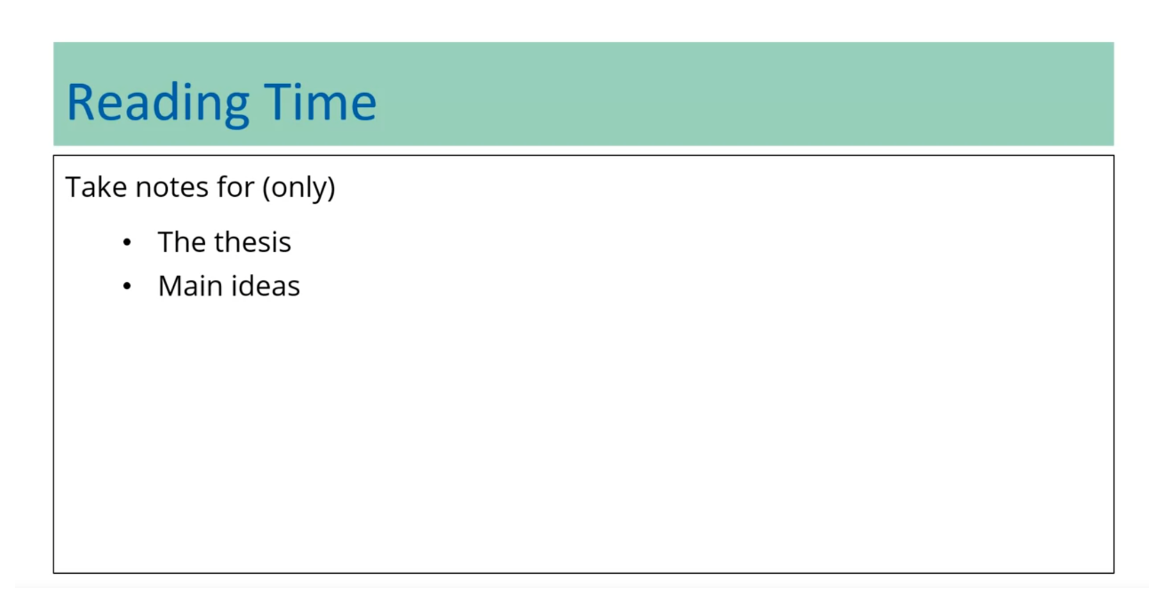
However, you’re going to
hear the lecture only once. So your notes maybe more detailed. Remember to include the thesis,
the main ideas as well as the reasons and examples mentioned by the professor
to support the main ideas.
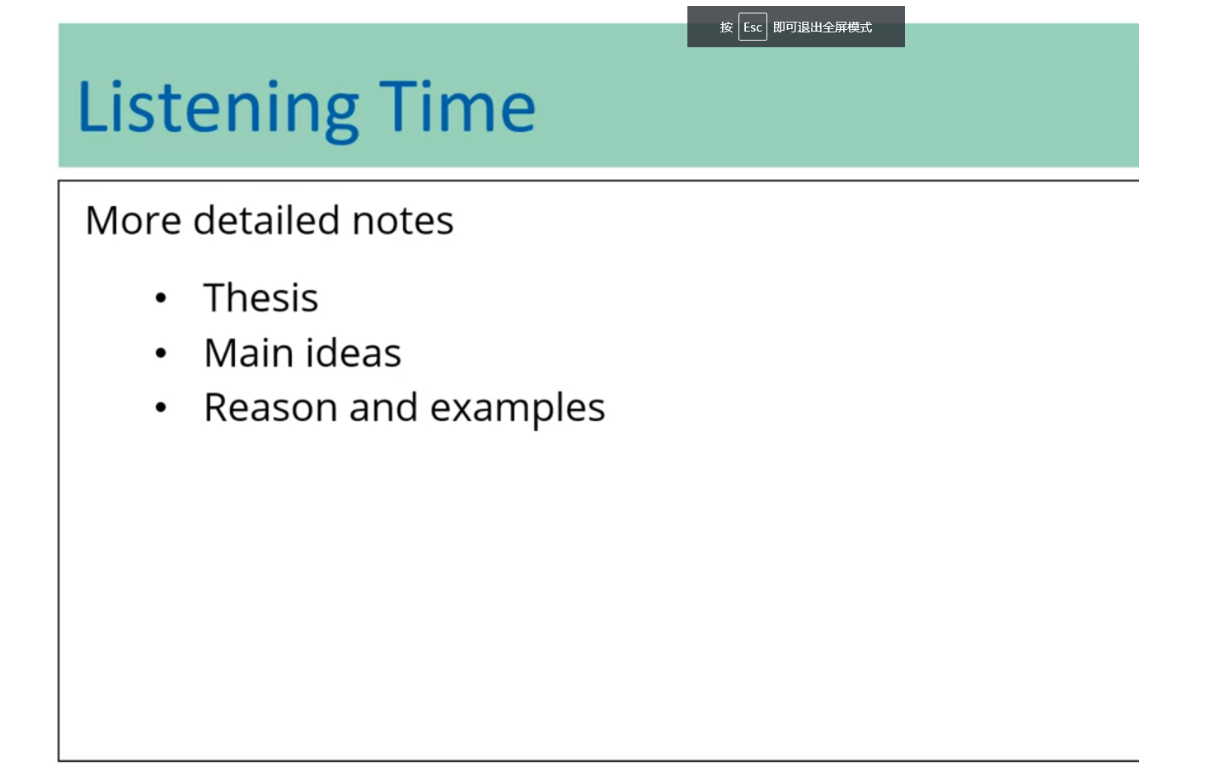
After reading and listening,
now you’re ready to type your responses. You sometime in pre-writing to plan
your outline by comparing your notes on the lecture with what is written in the
passage, which is now back on this screen. This is an example of an organized note. It contains information from the reading
on one side, and on the other side you can see the corresponding
information from the listening part. This will help you focus on comparing and contrasting the points from both
the reading and the listening.
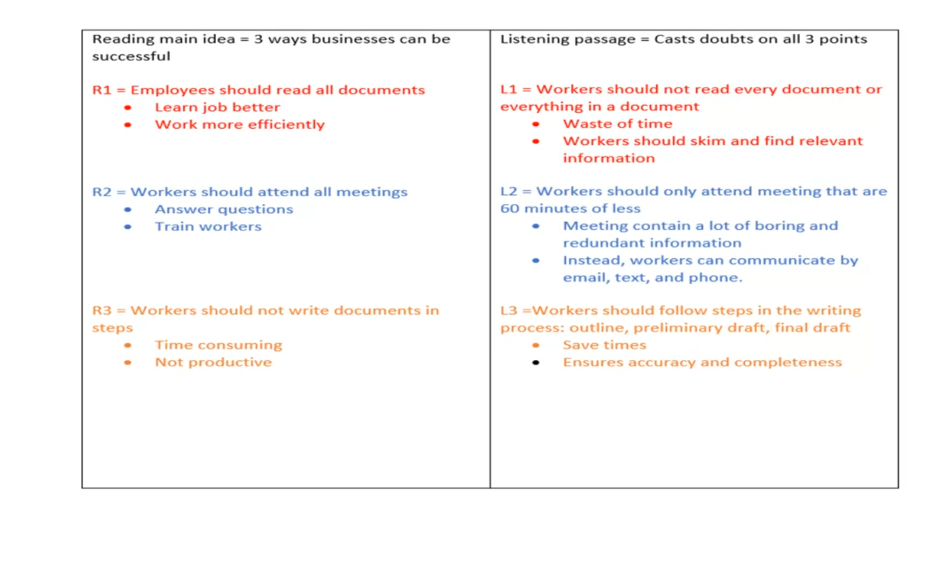
When you start typing, you want to make
sure that you’re able to summarize the information from both the reading and
the listening passage. You also want to make sure that you’re
paraphrasing the information and you are not merely copying anything. Also, you need to be able
to cite that information. Did you take those sentences
from the reading or are they mentioned by the professor. Also, you need to be able to
synthesize the information. How did the reading and
listening correspond to each other? Are they contradicting each other or
do they support the same idea?
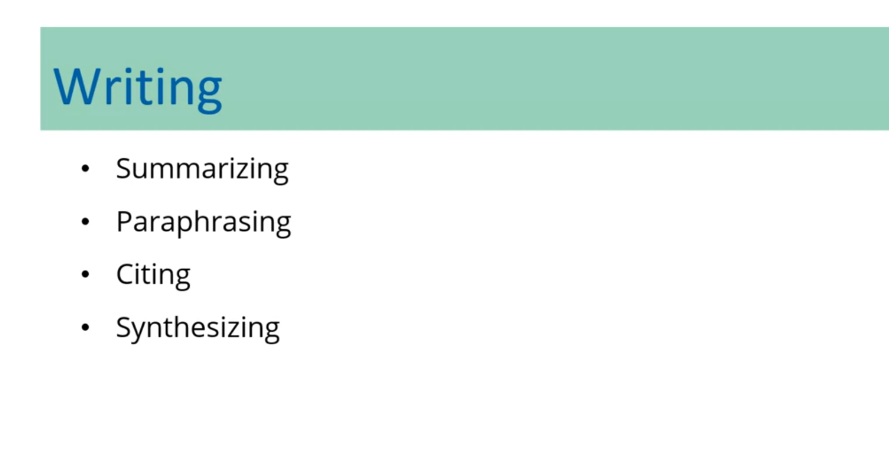
In course number two, module number three, we learn some templates that could
help you write and save time. But we’re going to look at some sample
answers and understand how readers are going to look at the structure and
the development of the ideas. Here’s the introductory part,
the reading passage and the lecture discuss whether
humans can coexist with bears and what to do in case of an attack. The professor from the lecture casts doubt
on all the points made during the reading. The reading passage holds that humans
should avoid living near bears. On the other hand, the professor from the lecture
argues that bears are not dangerous. This is a great introduction, because it synthesizes information
from the reading and the listening, and it’s very clear to
understand the thesis statement.
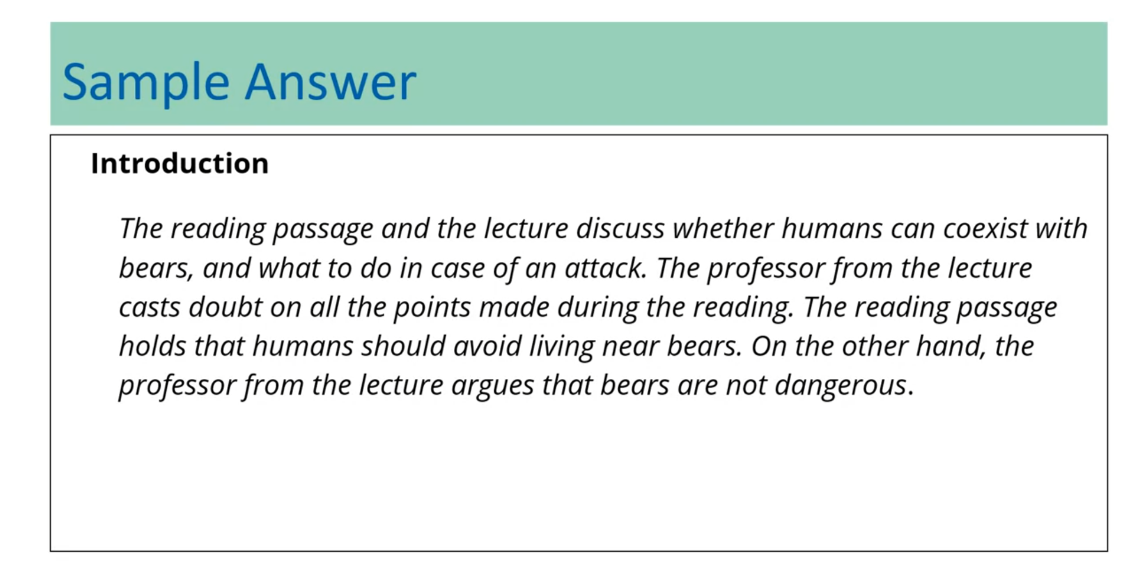
Now, let’s look at paragraph one. Firstly, the author from the passage, argues that bears are more likely to
attack humans when they do not fear them. Birds lose their fear towards
humans when they are fed by them. In contrast, the lecturer gives two
examples in which he denies this idea. In Minnesota and Pennsylvania,
bears coexist with humans, and no attacks have been registered. Besides very good use of transition words,
the writer has been able to contrast the ideas and quote and
cite examples mentioned by the professor, along with the reasons
mentioned in the passage.

Now, it’s your turn, take a few
seconds to read this paragraph and pay attention to all
the information that you can learn. What makes it a good body paragraph? Let’s begin reading. Here is the last paragraph of the essay.
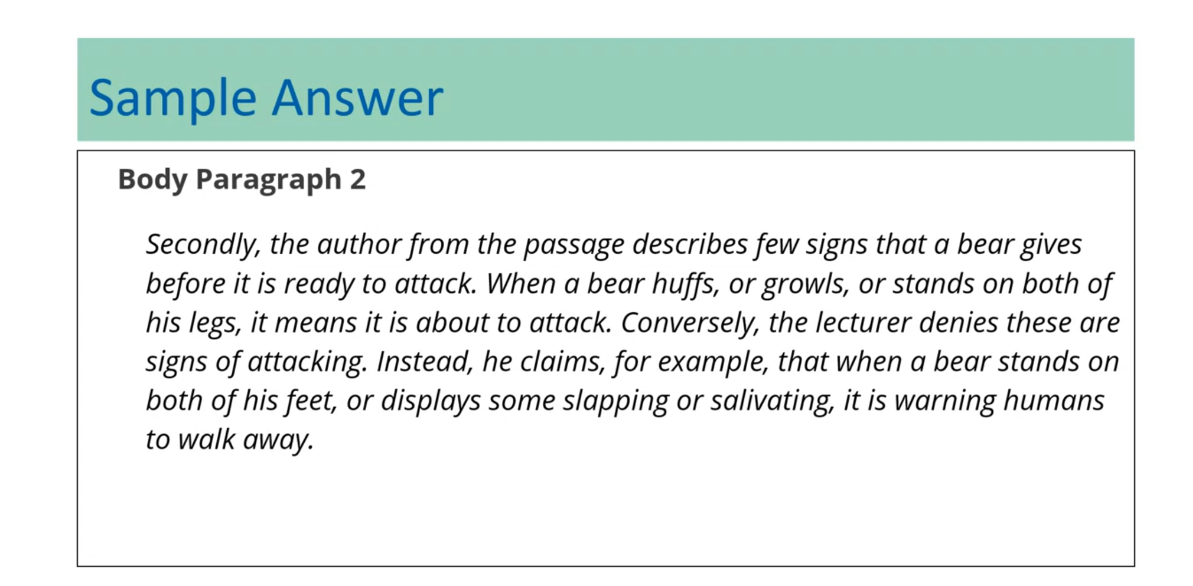
Again, you’re going to have 30
seconds to read this paragraph. Pay attention to the warning,
the transition words of vocabulary, grammar and spelling.
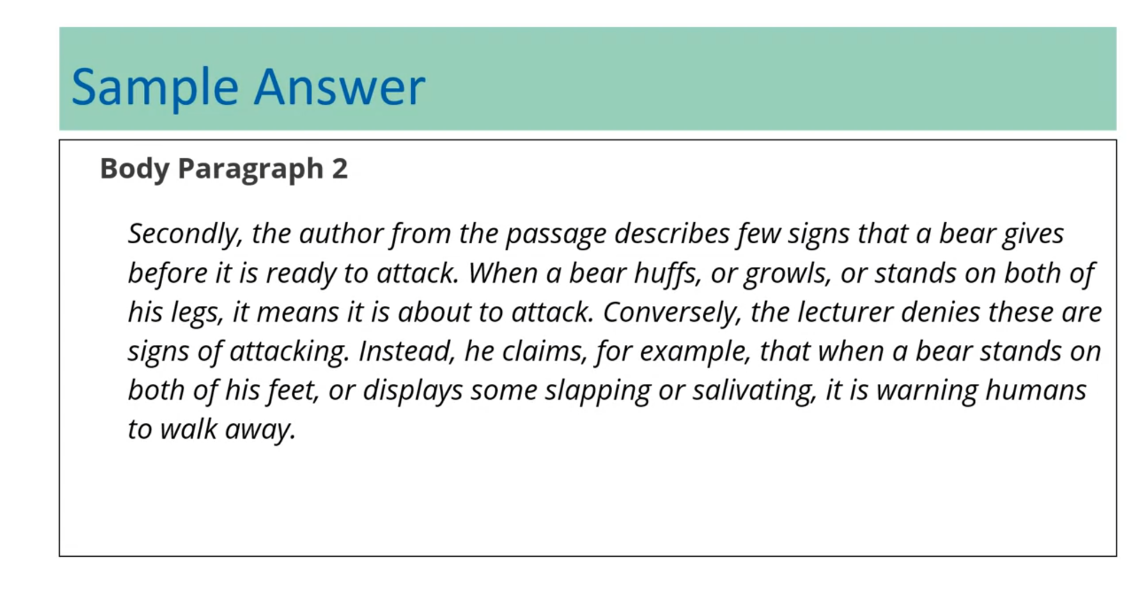
An essay like this can score very high. One reason is because it has excellent
control over sentence structure, punctuation and word choice. Also there is frequent voice markers
acknowledging the reading and listening passage. There is consistent use of simple present
tense reporting verbs throughout. There is complete and accurate
explanation of the most important points in the reading and the listening passages. Also there is logical compare-and-contrast
chunking organization, clearly integrating the reading
with the listening passage. Also there is effective use of
contrast transition words in key conjuncture of the essay. This is the end of part one and the second
part of this presentation we’re going to learn some strategies regarding
the independent writing task.
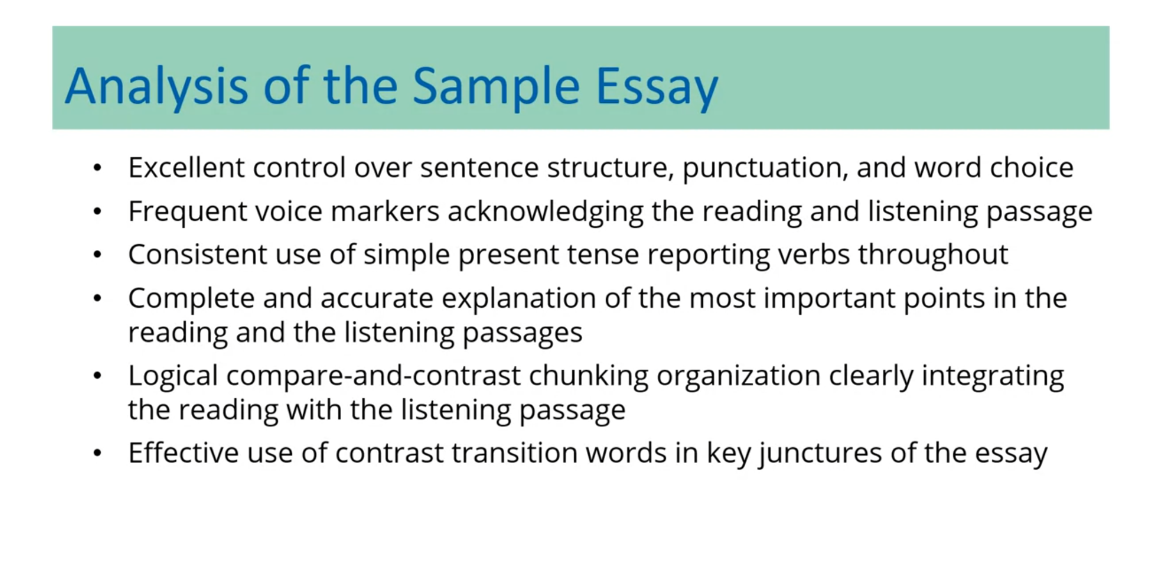
iBT Writing Strategies (Part 2)
Welcome back to this
presentation in the second part and the
last part of this module, we are going to look at
some writing strategies regarding the independent task. You might be tempted
to start typing your answer right away
when you see the prompt. But it’s a good idea to spend about two to five minutes
for the pre-writing phase. This will help you
read the prompt, think about the prompt, brainstorm and take notes, and also make an
informal outline. If you don’t skip the prewriting, you’ll be able to save time. In the writing phase, you will have 20-22 minutes to write a standard four or
five paragraph essay, which includes introduction, body paragraphs, and conclusion. We looked at some templates in course number two, Module four. Even though 30 minutes isn’t a long time to write an essay, you still want to save a few
minutes towards the end of your writing time in order
to correct the content, grammar and mechanics
like punctuation.
Editing content areas can
help you have a better score. You need to fix problems in the introduction
and ask yourself, is there a clear
thesis statement? Does it accurately
restate the prompt? Makes sure you don’t copy
statements from the prompt. Also check problems
in body paragraphs. Do this sentences support your opinion into
thesis statement? Are there enough reasons,
examples, and details? Do the ideas flow clearly from one sentence to another and
from paragraph to paragraph? Are there problems
in the conclusion? Is there actually a
concluding sentence or paragraph that gives the
feeling that the essay is over.

As you remember, language
accuracy is part of your score and you need to edit your essay for
grammatical errors. Look and make sure
that you don’t have any sentence fragments
or run-on sentences. These are sentences that
look like a sentence, but they’re not
actually complete. Look at your verbs. Do you have errors? Have they’d been used correctly? How about pronouns? Have you used singular pronouns instead the plural pronouns? Singular and plural errors. Do you have plural
s’s for plural nouns. How about incorrect word forms. Have you used and noun
instead of a verb. All of these can be fixed in the last two to five minutes
of your writing time.
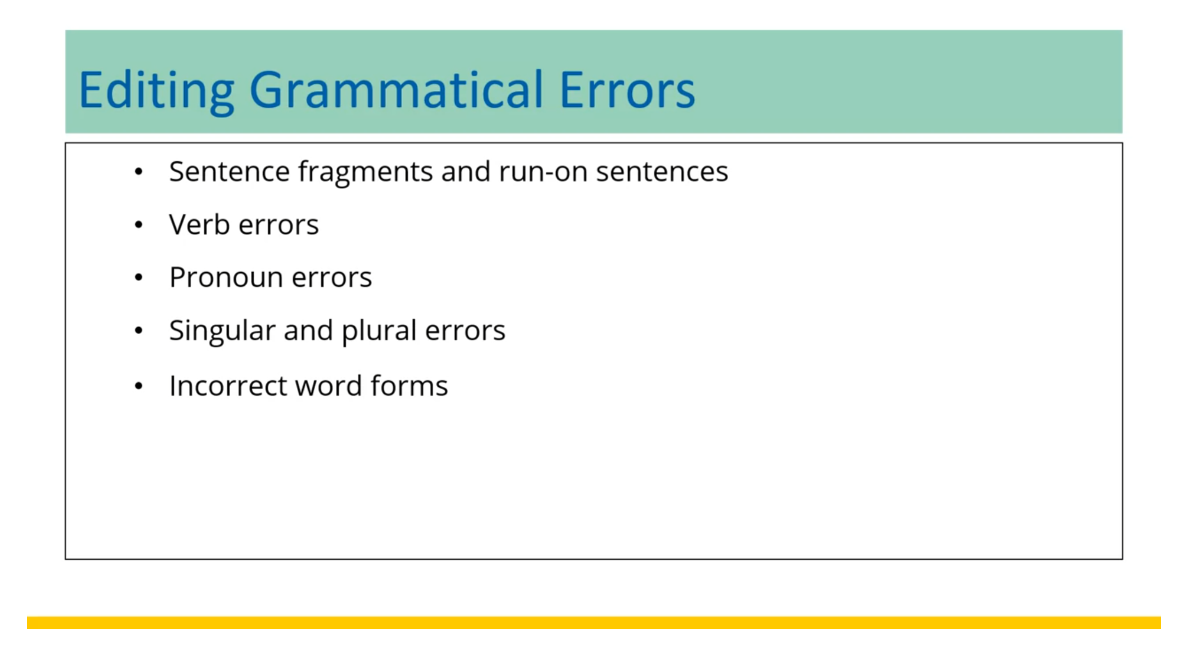
Finally, make sure
that you’re able to edit your essay for
mechanical errors. These include spelling errors, punctuation errors, capitalization errors,
and paragraph problems. Remember, you don’t have
auto text correction. You might have made mistakes, and spending a couple of
minutes towards the end of your writing time can help
you fix these problems.

Now, let’s look at a sample
question and see how these strategies can help
you improve your writing. Read the question below. You have 30 minutes to plan, write, and revise your essay. Typically and
effective essay will contain a minimum of 300 words. Do you agree or disagree with
the following statement? Always telling the truth is the most important consideration
in any relationship. Use specific reasons and
examples to support your answer.
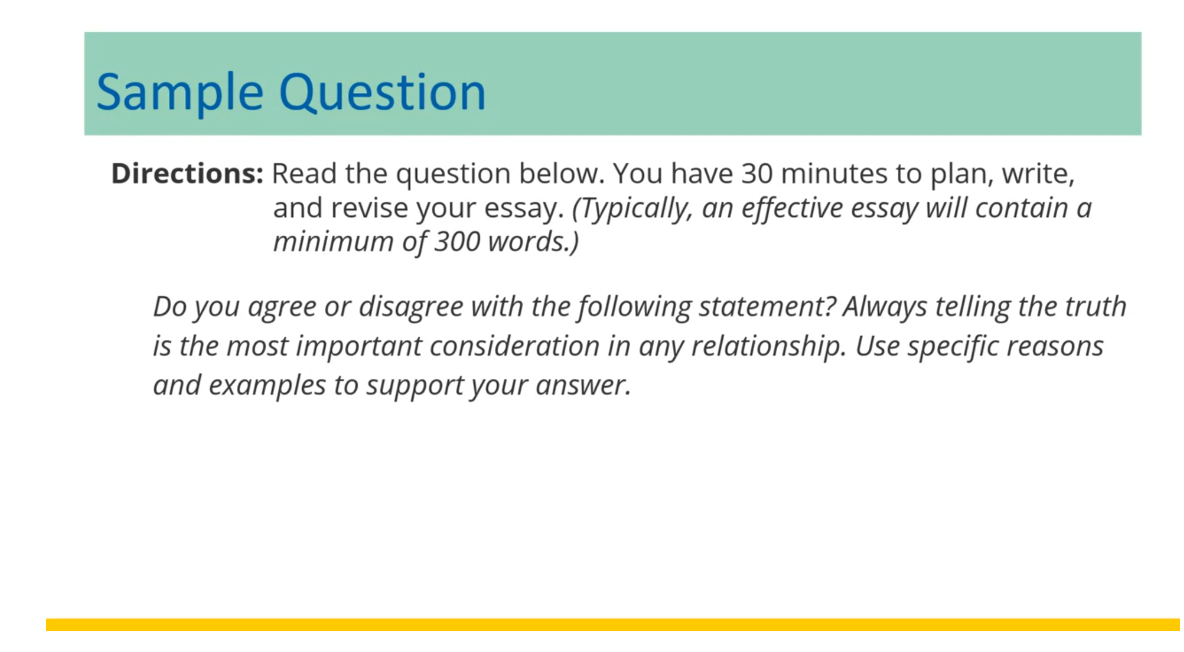
Now, let’s take a look
at this Introduction based on the topic
that we just saw. The traditional virtue
of telling the truth in all situations is increasingly doubted by many in today’s world. Many believe that
telling the truth is not always the best policy
when dealing with people. Moreover, the line of a truth is becoming
more and more vague. This essay will explore
the importance of telling the truth in
relationships between people. The introduction is great
because it clearly analyzes the prompt without copying the information in the
question we just read. Also, it’s very
clear to know what the writer is going to talk
about in the body paragraph. In other words, the thesis
statement is clear.
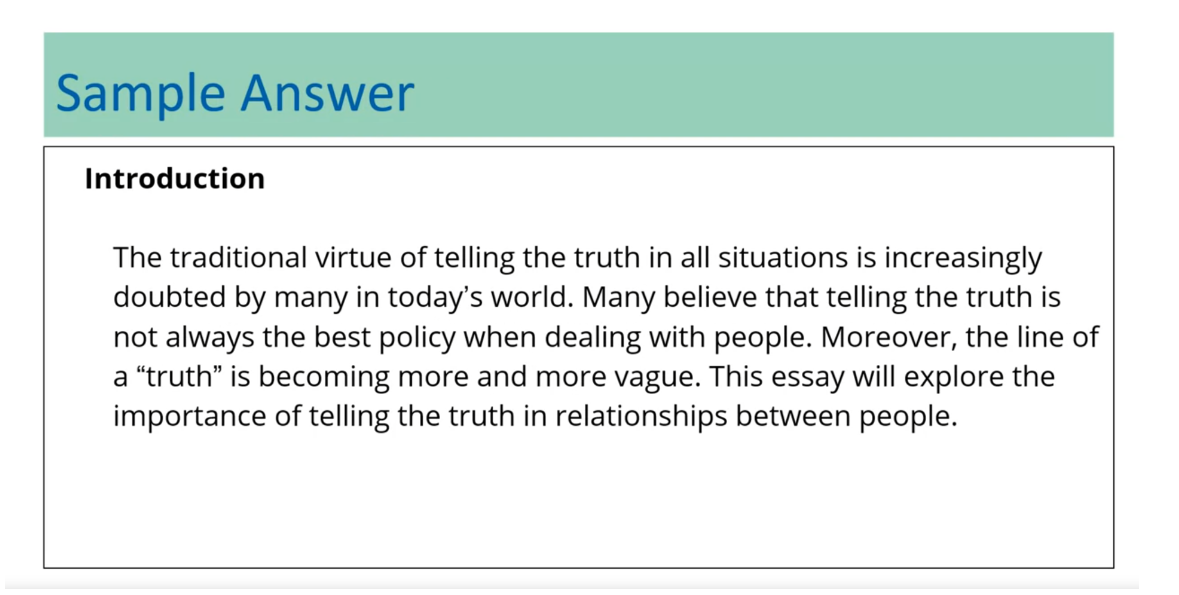
We’re going to skip looking
at the body paragraphs and look at the conclusion here
in this sample question. The reason is that even
though our time is short, we might be tempted to write a long conclusion
which isn’t necessary. Your conclusion can be as
short as one or two sentences. Here is an example. Overall, it is understood that relationships are
founded on trust, which goes hand in
hand with truth. Indeed, telling the truth is the most important
consideration in any relationship
between people always. This conclusion is enough
because the reader can get the sense of the final
statement in the essay.
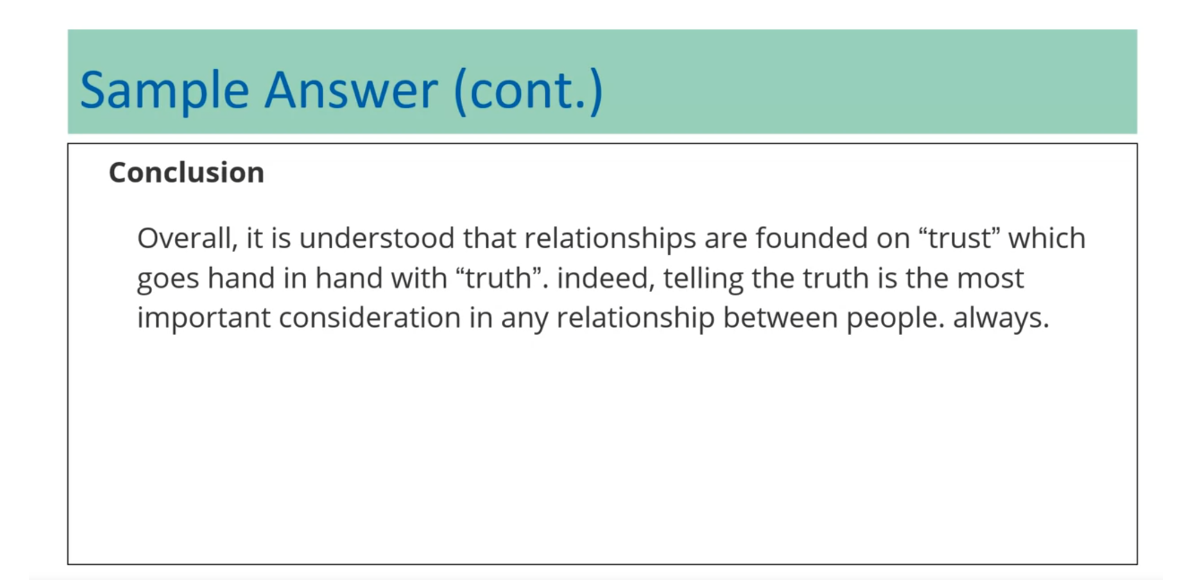
This is the end of this module and also the end of the course. We hope that the
course was helpful in preparing you for
your future IBT test. Before we leave, please remember the key advice, practice,
practice, practice. There was a lot of information in this course if you
were brand new to IBT. You might need to go back to the presentations and
refresh your memory. Also, practice with a lot of sample tests and
sample responses. Best of luck on your IBT journey.
Quiz: Writing Tips & Strategies
My choice:

Answer:
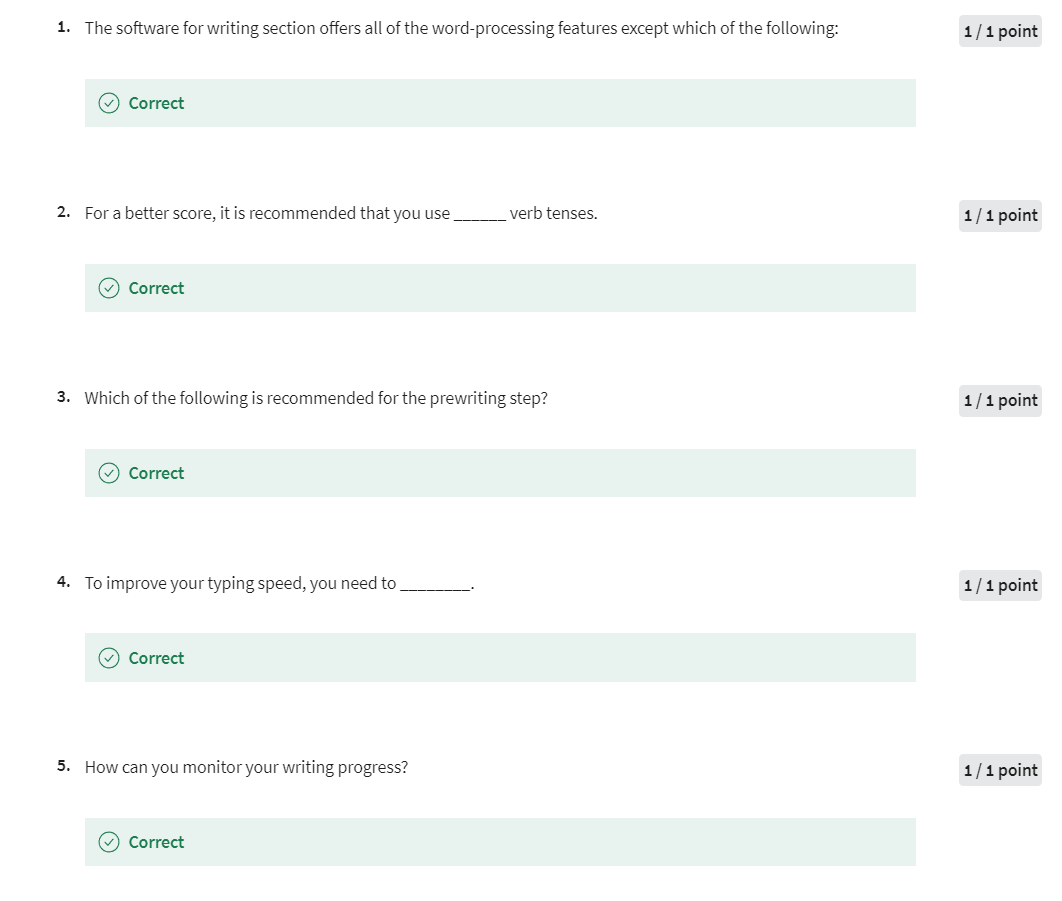
后记
2024年4月5日花费2个小时完成这门TOEFL备考策略的课程,接下来就是分模块(听说读写)进行练习practice。2024年4月5日完成了这个Specialization,共计三门课。



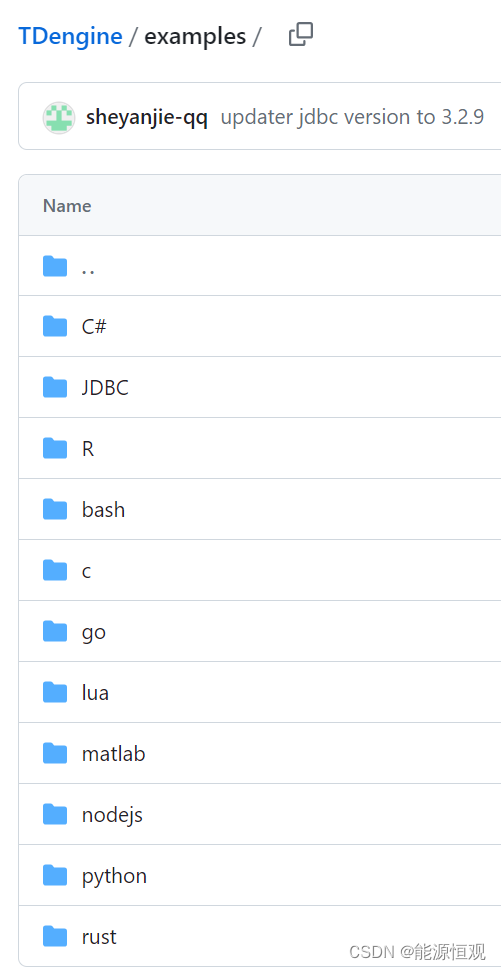
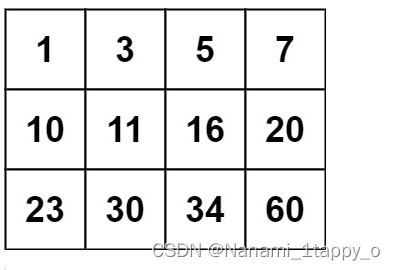

![别让.[[hashtreep@waifu.club]].svh勒索病毒盯上你:一份实用的科普与防范经验](https://img-blog.csdnimg.cn/direct/5a20660cf7e540aa8c52cf5d9b6cdd97.png)

